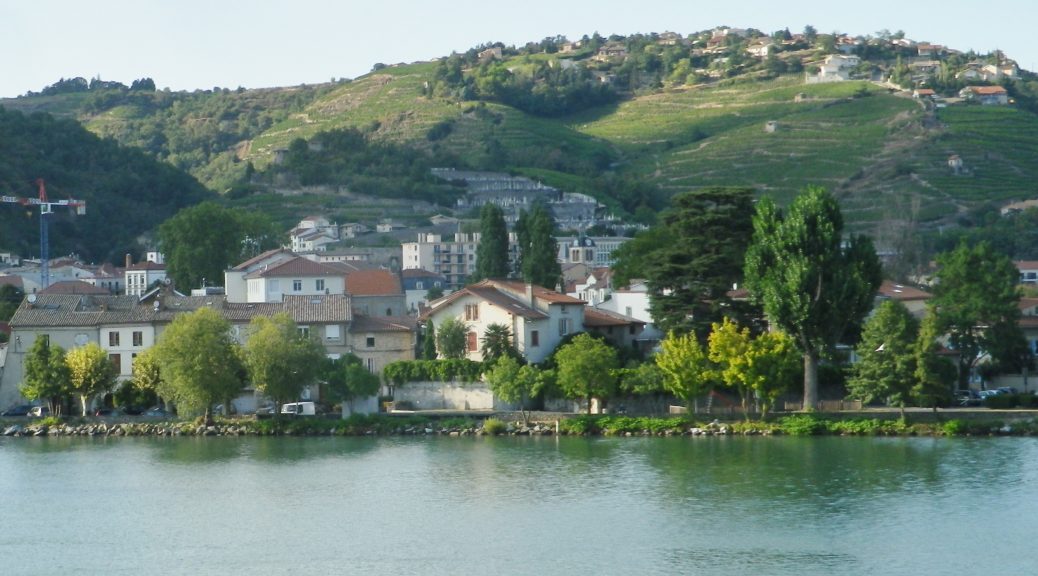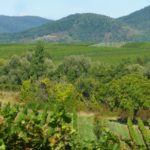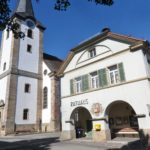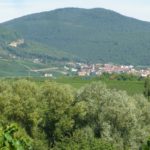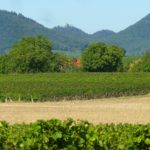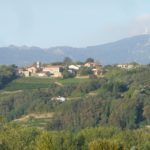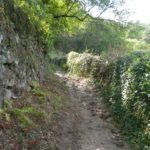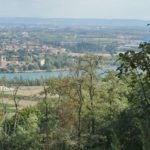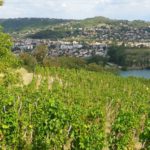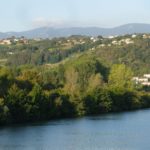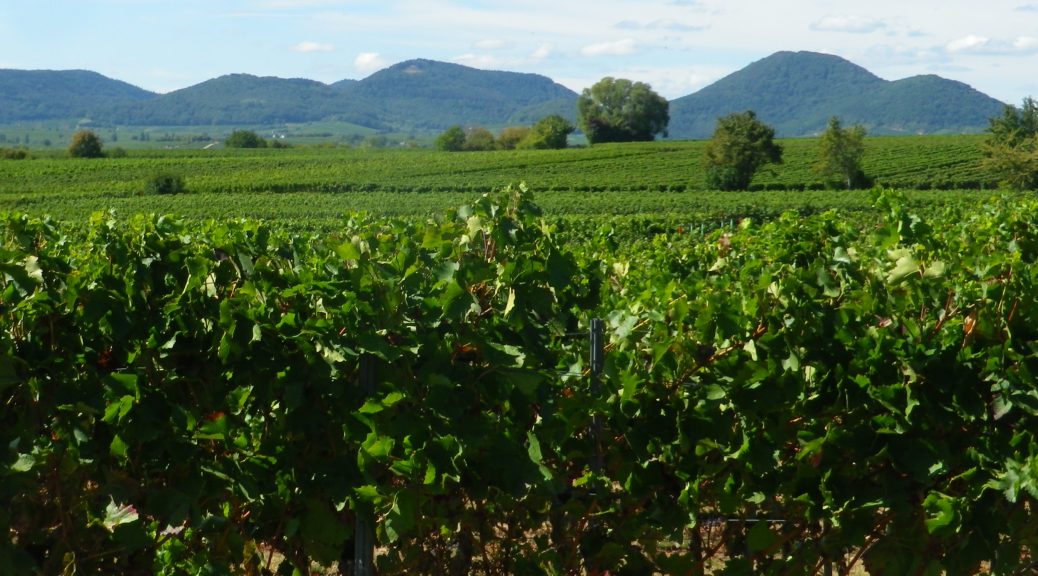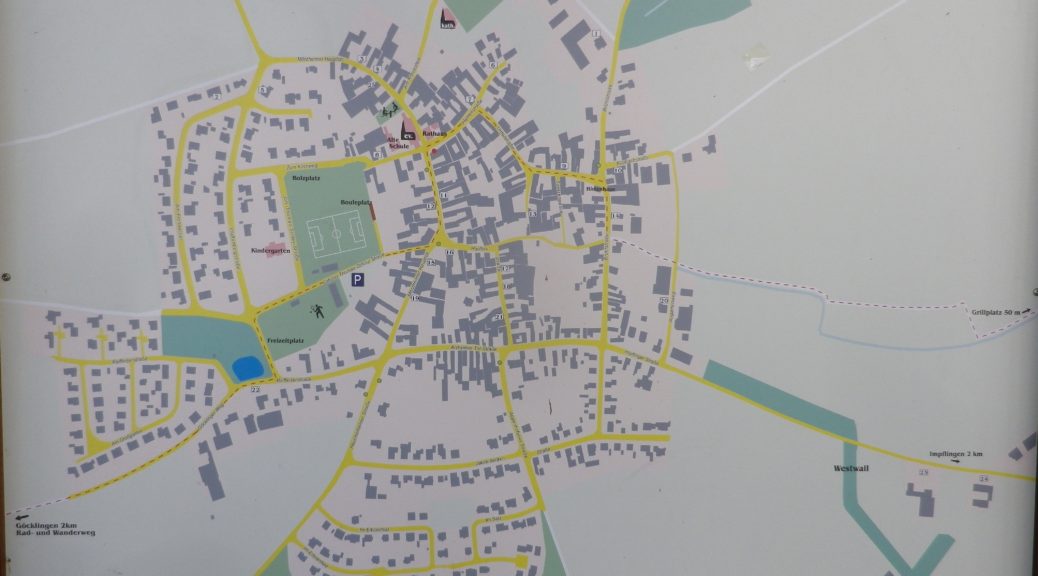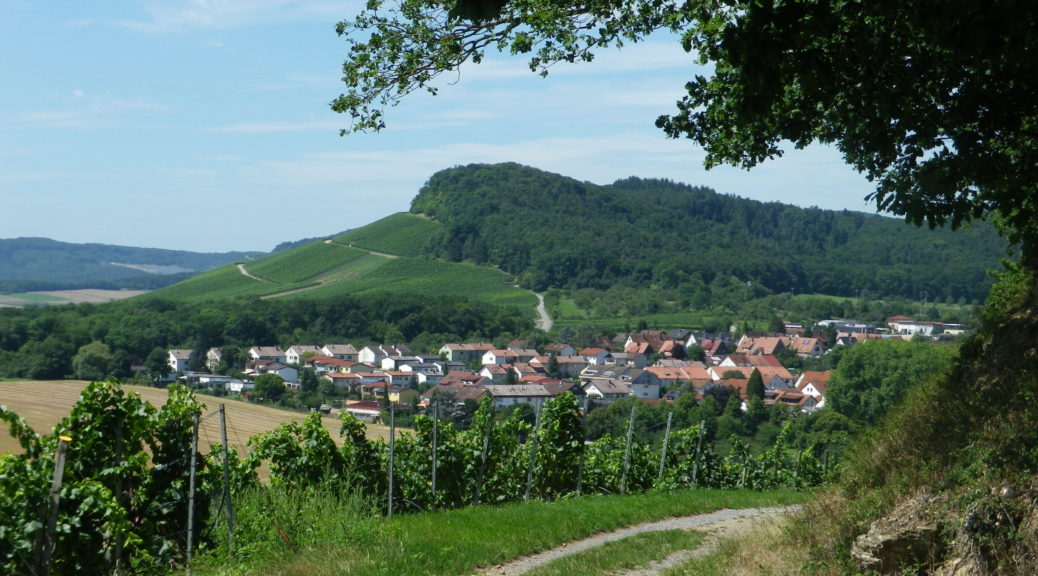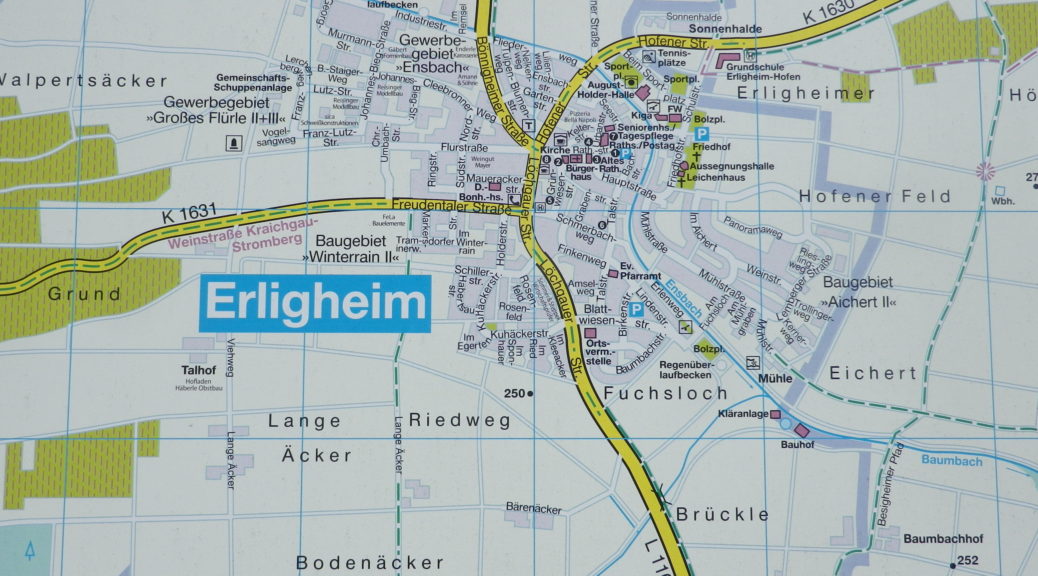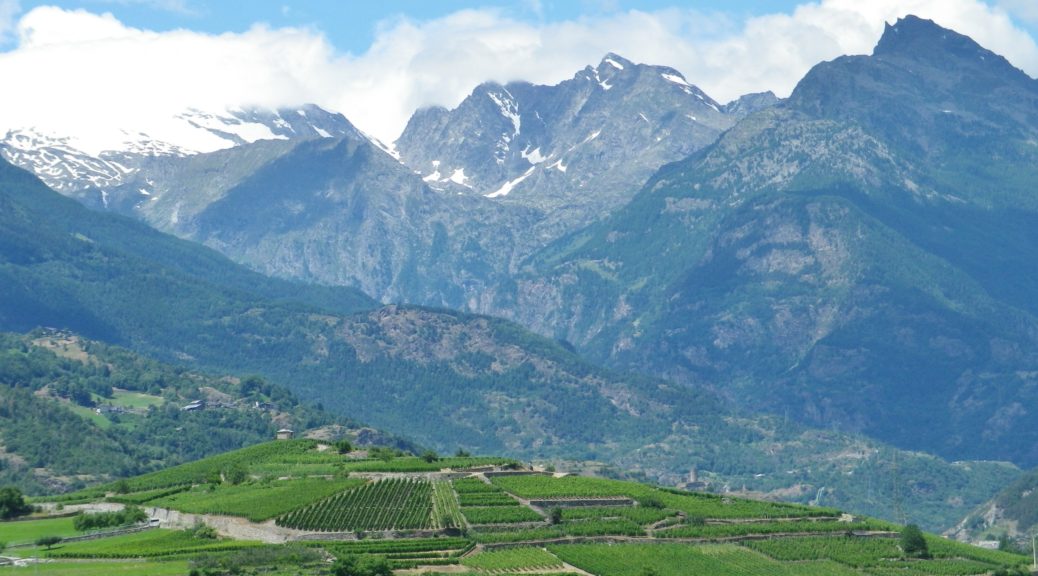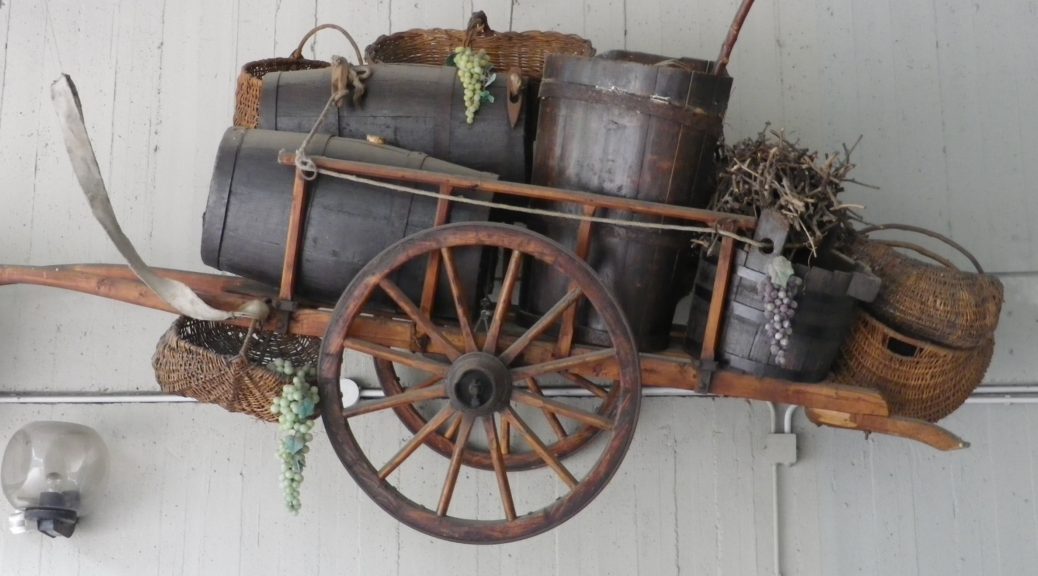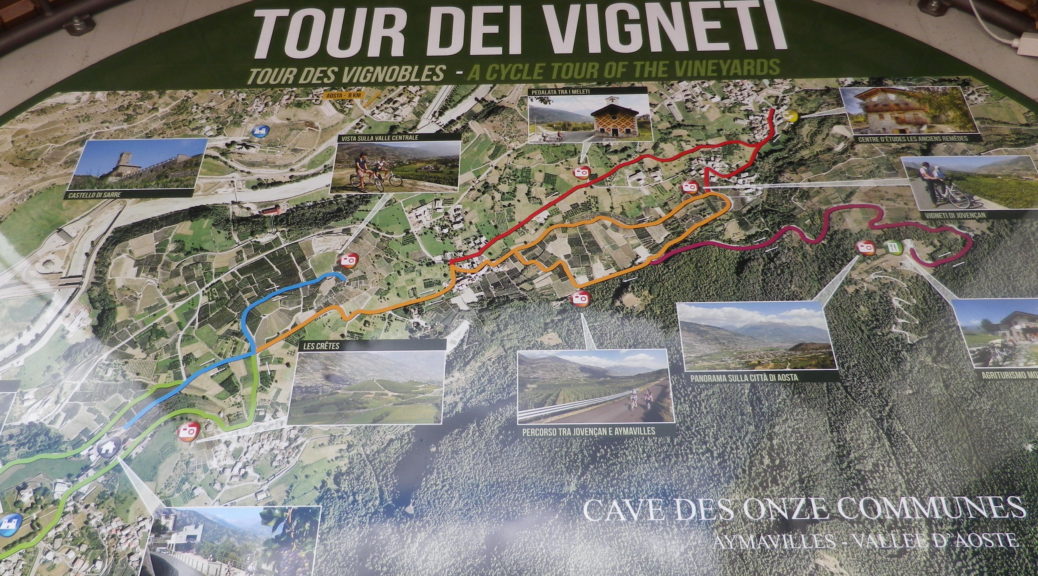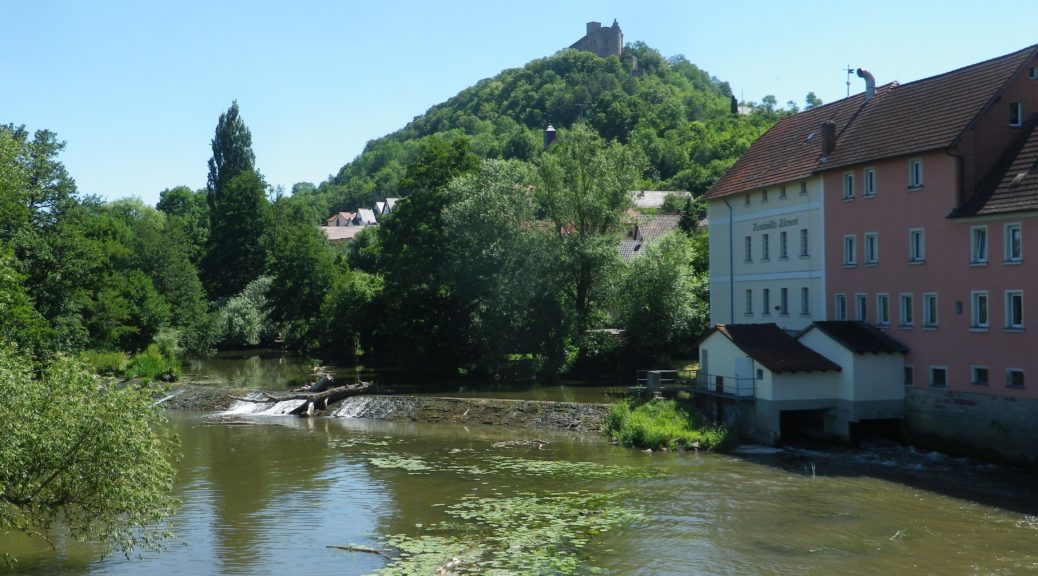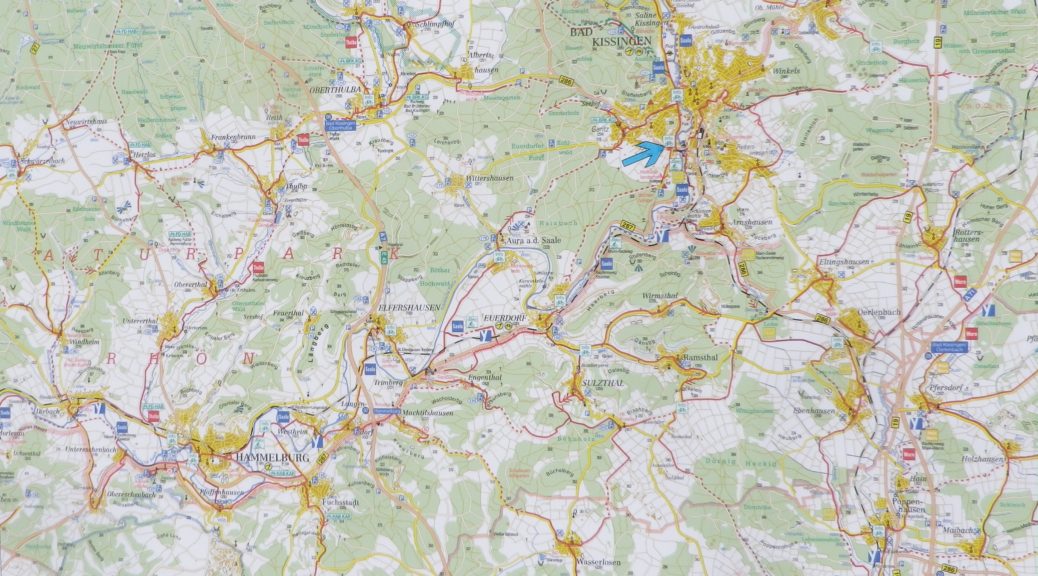Tag Archives: biking
Vintners and Their Vines
As anyone who earns their living by the soil will tell you, the fields are important. As those who make their living by grapes know, each individual parcel of the vineyards is very important and rather unique. Like most vintners, those of Suedliche Weinstasse feel a deep connection with the land, and attempt to maximize the potential of the terroir and microclimate for each parcel, and carefully match that with each varietal planted. Parcels may be adjoining, or separated by a couple of kilometers. To access these, vintners use agricultural lanes, most of them as well tended as the vineyards they serve.
This bicycling itinerary led mostly along these lanes, through acres of vineyards, both in prime condition. The itinerary was called the Winzerradrundweg, or Vintner Bicycle Circuit Trail. Previously, vintners and vineyard workers, usually family, may have ridden bicycles to access distant parcels. Today though, they use cars, and compact trucks, and cyclists use these quiet lanes to explore this beautiful countryside.
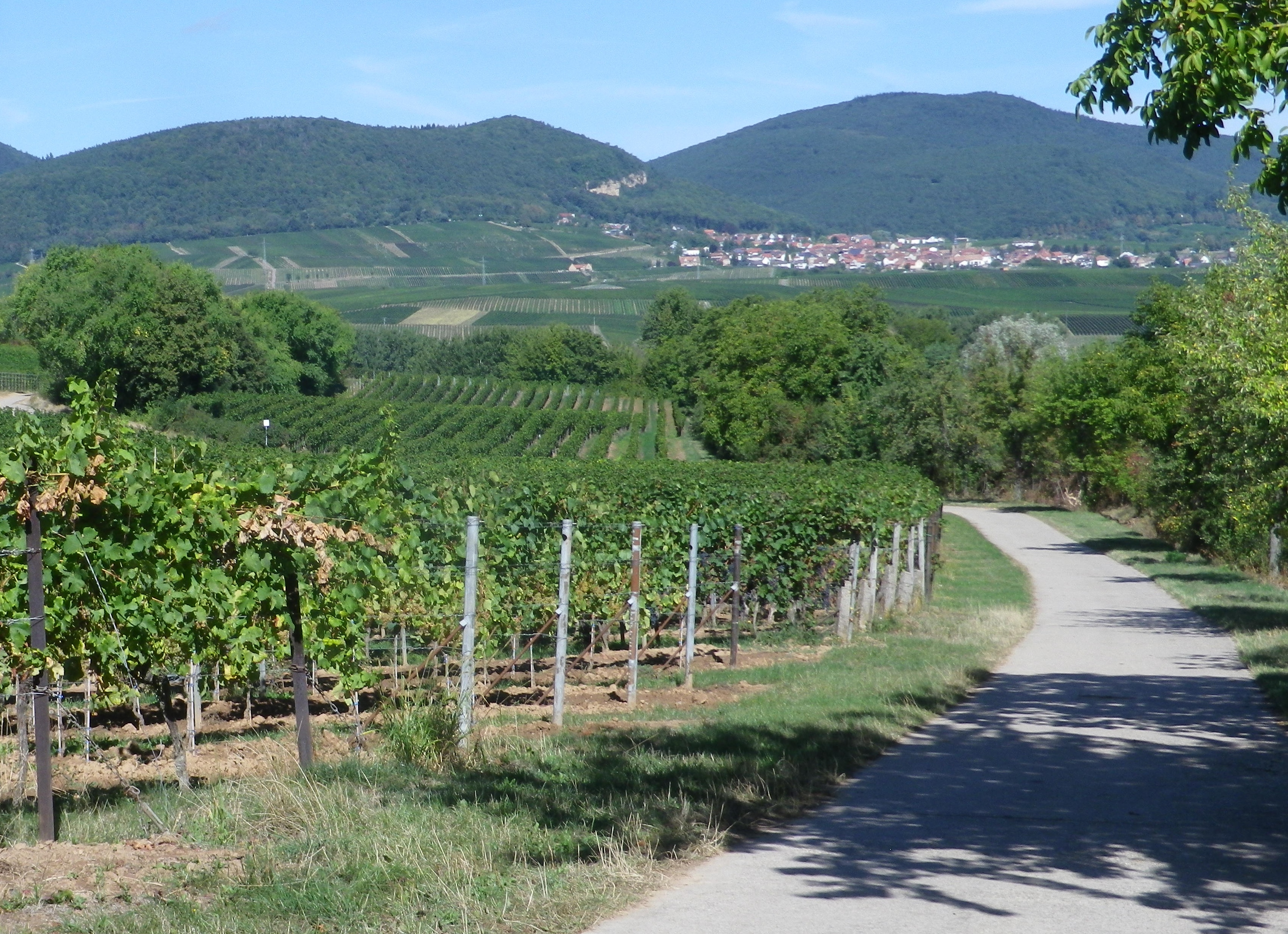
However, starting in the city of Landau in der Pfalz, the first two or three miles pass through wheat, corn and cabbage fields. There, I had my first encounter ever with a (John Deere!) farm combine. Curving upward from a steep gully, lined by high hedgerows, I first heard it, then only saw it, as it barreled down toward me on a lane rather narrow for it, let alone me and it. This thing was huge, about two stories tall! Happily, it suddenly veered to the right to begin harvesting the corn in an expansive golden field. Sadly, I didn’t get a photo. Shortly thereafter, I entered vine country, where such large machines are not used, not in Germany at least.
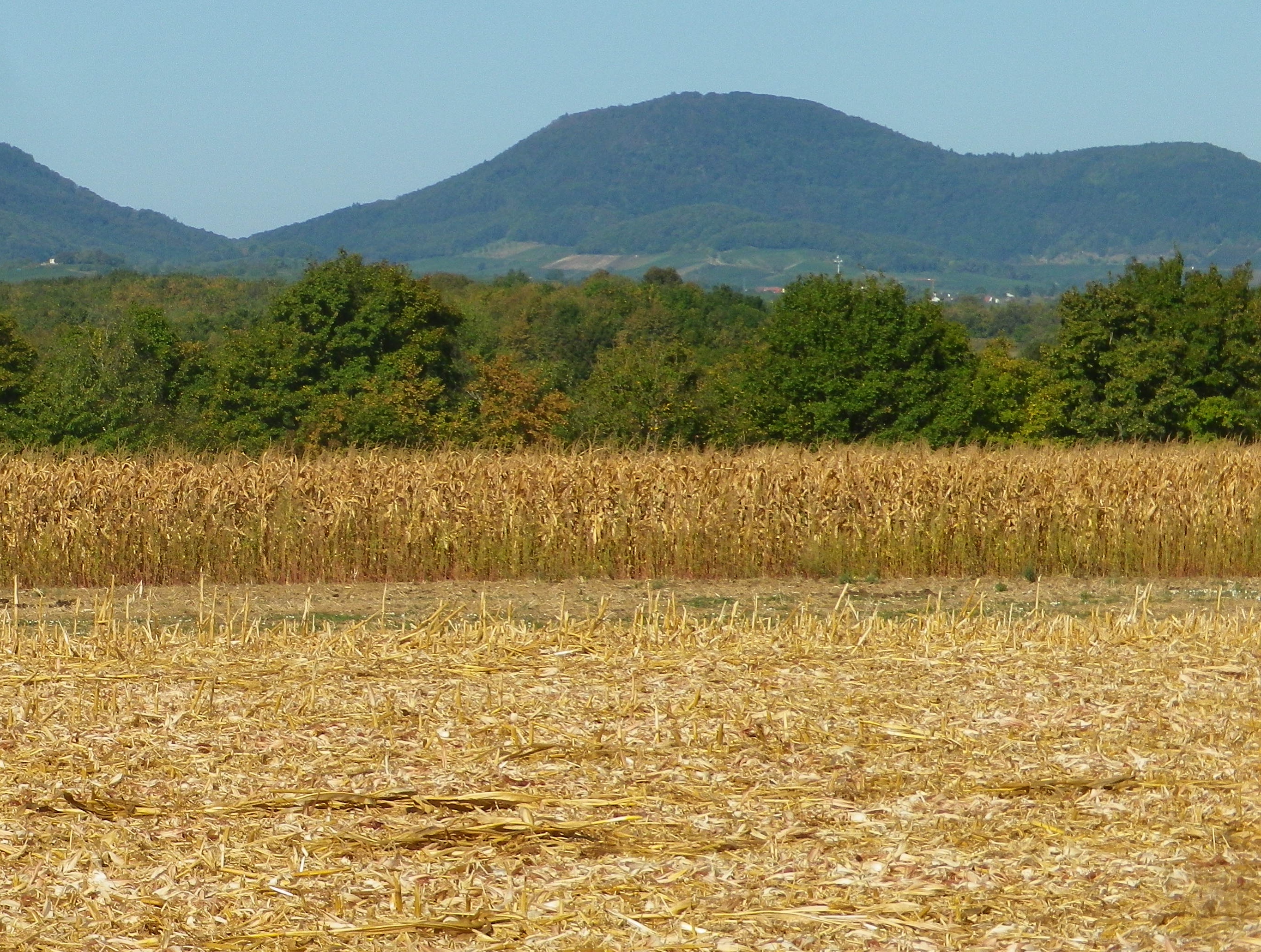
Two things to notice on this itinerary: the terrain for vines is distinctly different than the terrain for fruits and vegetables. The vineyards started where the flat fields left off, and hills or ridgelines began. The other noticeable difference was in the composition of the villages: the vintner family houses and businesses tended to be set in the villages, whereas the farmers tended to live on the edge of town.
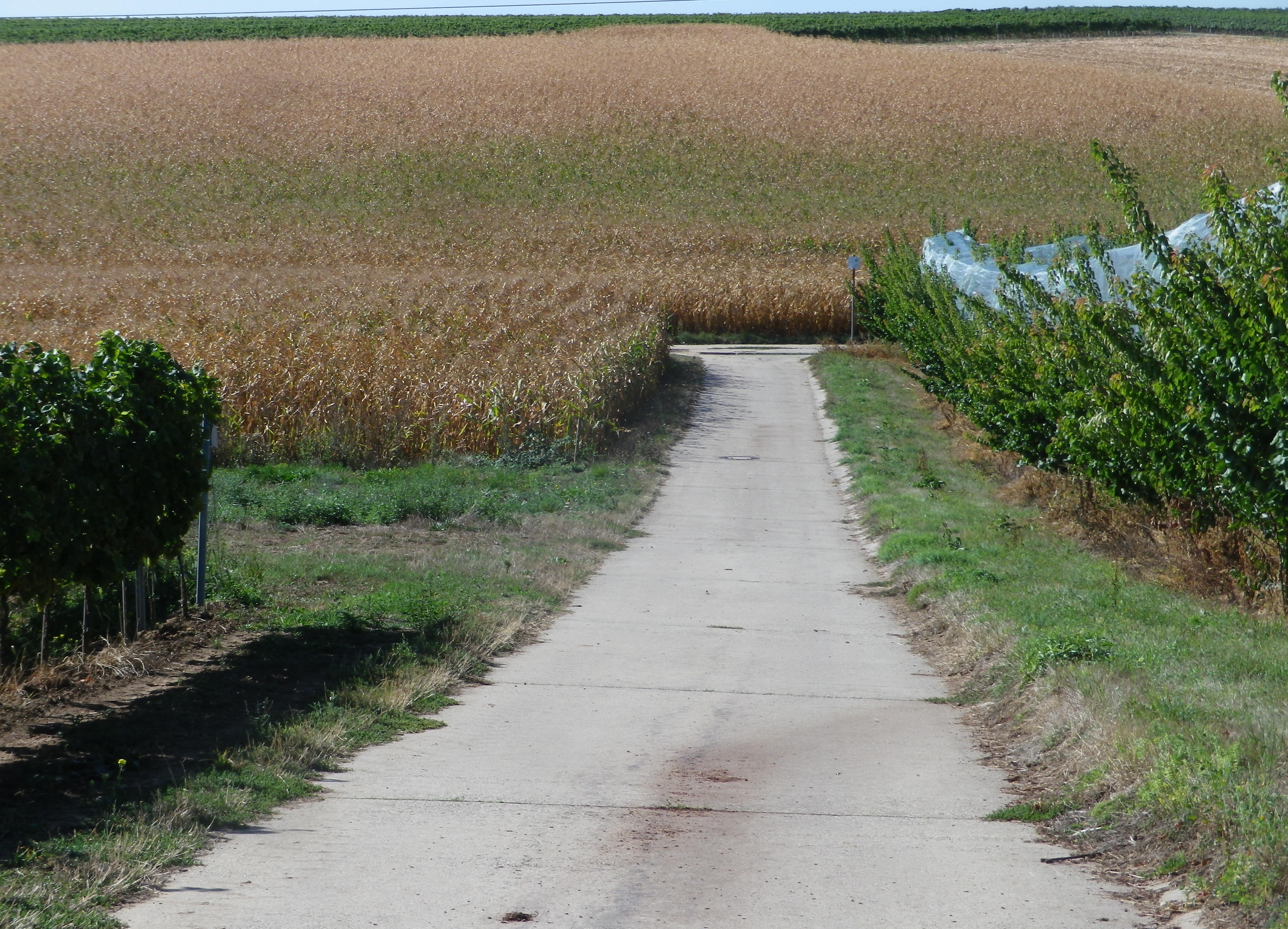
Going through the first vineyards, I noticed that harvest had yet to begin. The vegetation, last cut back weeks ago, while trim, was lush and now filled out. The grape bunches hung heavily on the vines. These vineyards while full of grapes, were empty of people. Presumably, the vintners were at the wineries, busy preparing the equipment and cellars for the harvest soon to come.
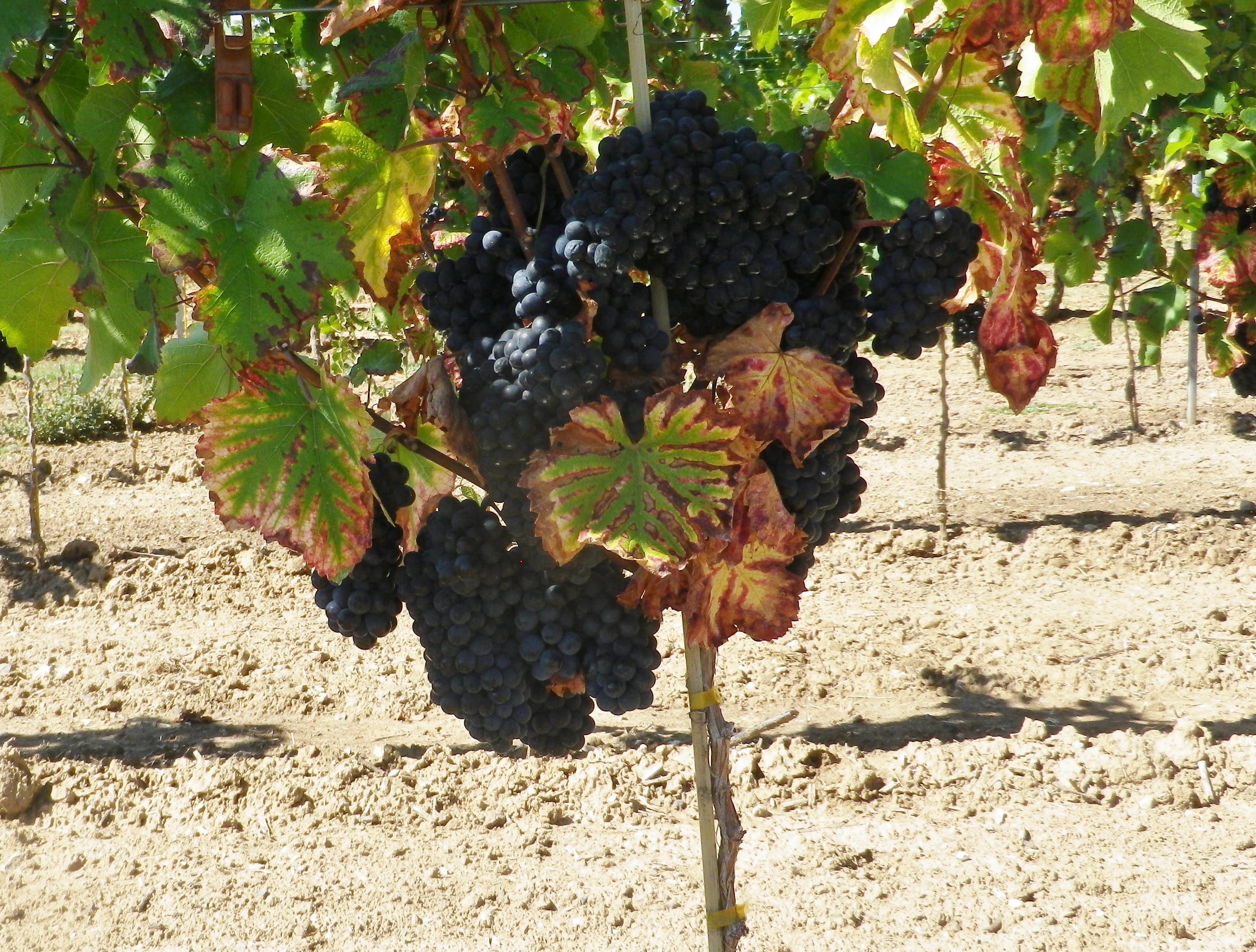
At first, the vineyards were interspersed with corn or vegetable fields in the flat areas in between. This area is one of the “garden” spots of Germany, so there is a diverse agricultural scene here. This was especially true around the villages of Insheim, Knoeringen and Dammheim. But that began to change as the trail approached the base of the Haardt mountains.
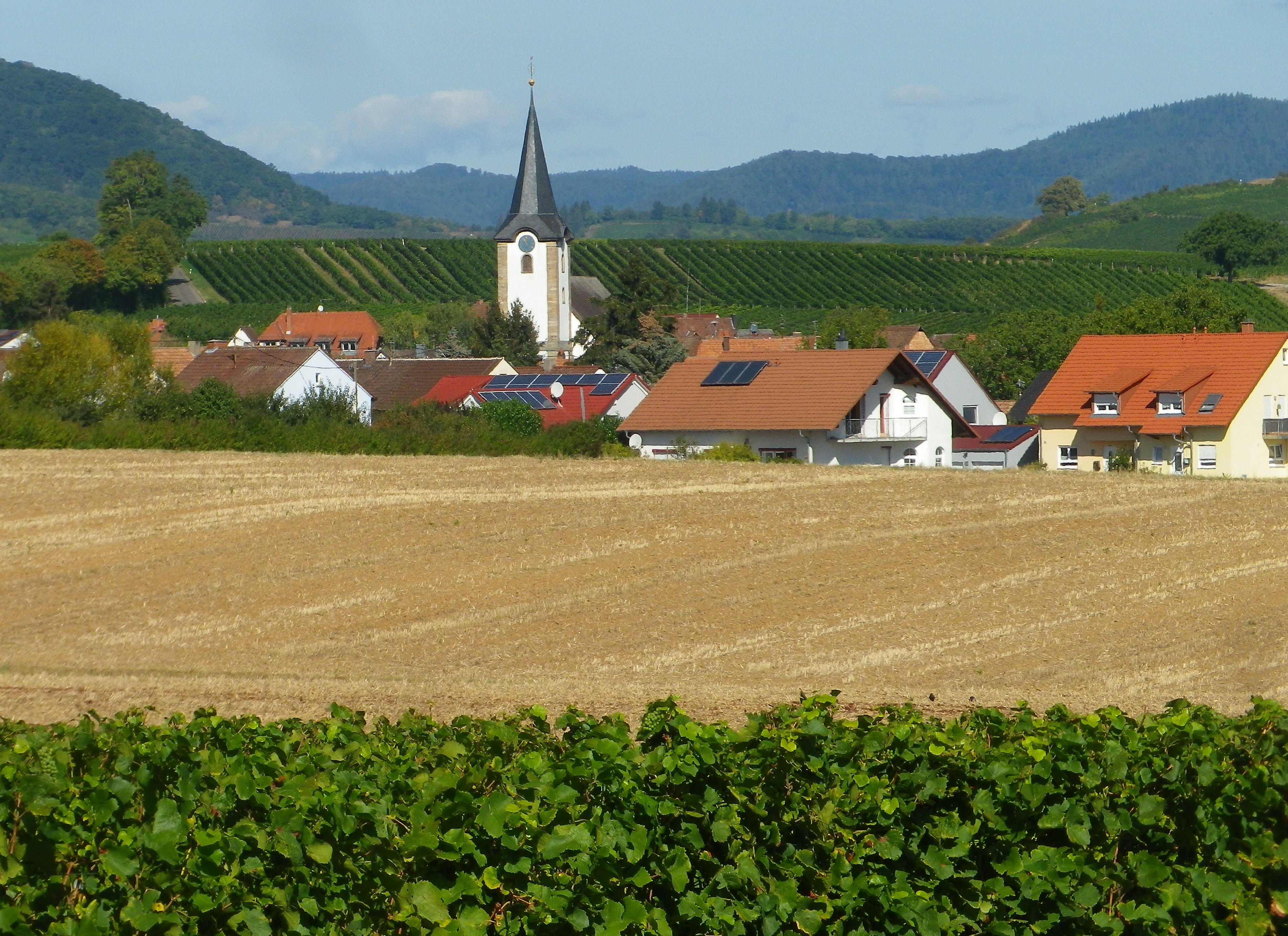
The vineyards predominate once west of the village of Moerzheim. Kilometers of vineyards, each sited with precision, arrayed magnificently along the vintner lanes, which were proving ideal for cycling. The lush green vegetation looked gorgeous under a brilliant sun and a clear blue sky. They were interrupted only by the neat and compact winemaking villages of Wollmesheim, Ilbesheim and Arzheim. Once I reached Siebeldingen, I was at the home of German grape varietal development, the Institut fuer Rebenzuechtung, where experimental new varietals are scientifically engineered, cultivated and tested every year.
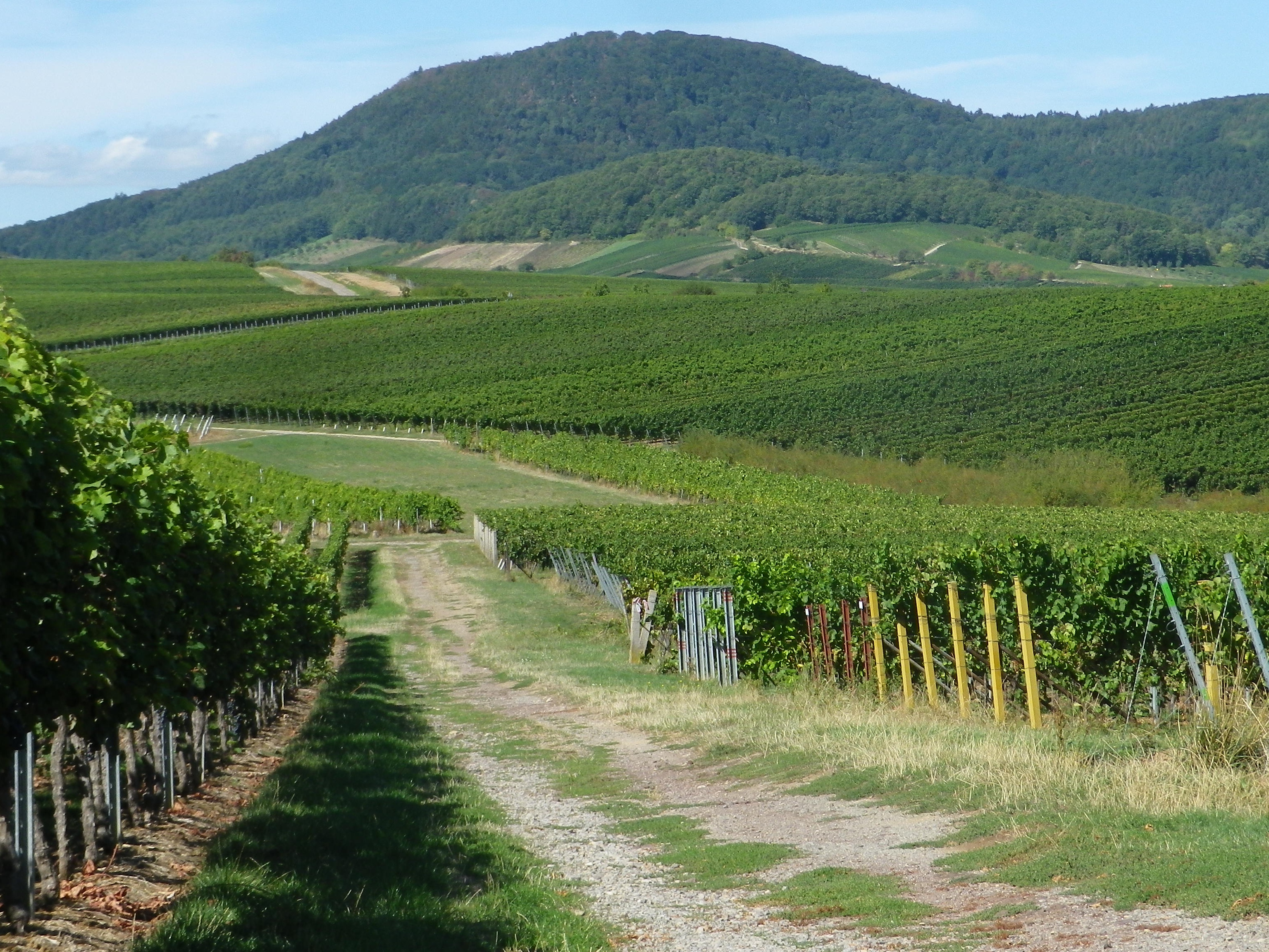
The itinerary followed up and over ridgeline after ridgeline. On top of each ridgeline, the views were tremendous. The flat lands of the Rhine River Valley stretched east to Baden-Wuerttemburg, where the base of its tree-lined ridges stood out well on this crystal-clear day. Seemingly near enough to touch, stood the Haardt mountains to the west. Some of its beloved red sandstone landmarks clearly stood out against its dark pines. There could not have been a better day for cycling this trail.
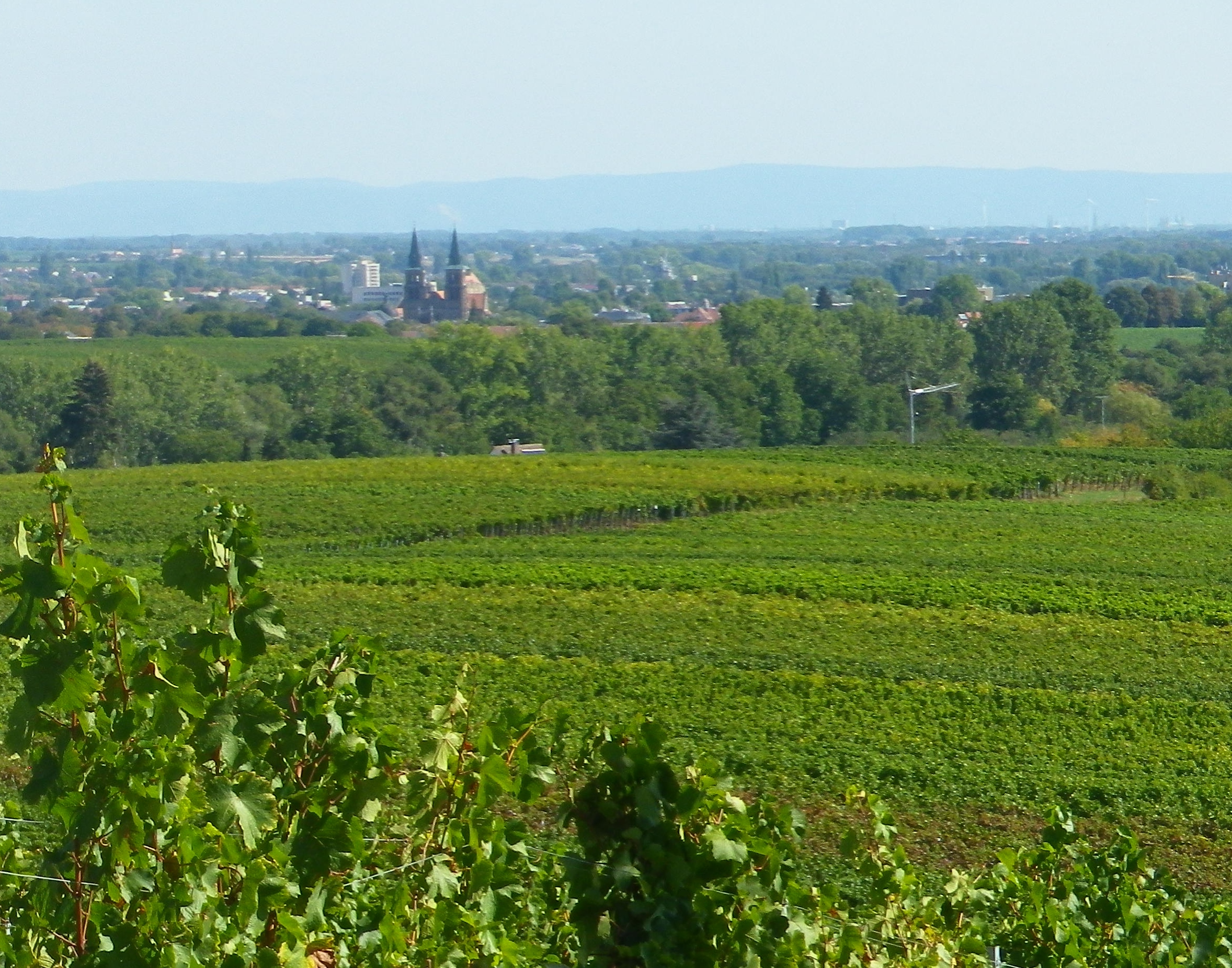
The occasional village provided opportunities for something to eat or drink. But the village of Nussdorf really stood out. Set in a sea of vines, this little village which once sheltered Roman-era vintners, really celebrated its viticultural heritage. Nussdorf’s unique wine education trail (Weinerlebnispfad), complete with picnic benches, a wading pool for aching feet (Kneipp), and a rest area, also partly served as the itinerary for this section of the Winzer Radrundweg. There were several sculptures celebrating the life of the vine, and chimes lined the trail, awaiting the inspirational touch of passersby to bring sound to the vineyard. Flowers, usually roses, marked the end of rows of vines. (Historically, vintners used flowers to lure insects away from the vines, thus protecting them.) Speaking of celebrating, in addition to hosting several wine festivals throughout the year, some enterprising local vintner also had what looked like a large prairie schooner (Planwagen), apparently rented by a group of partygoers, enjoying the local wines as they were drawn along the wine trail.
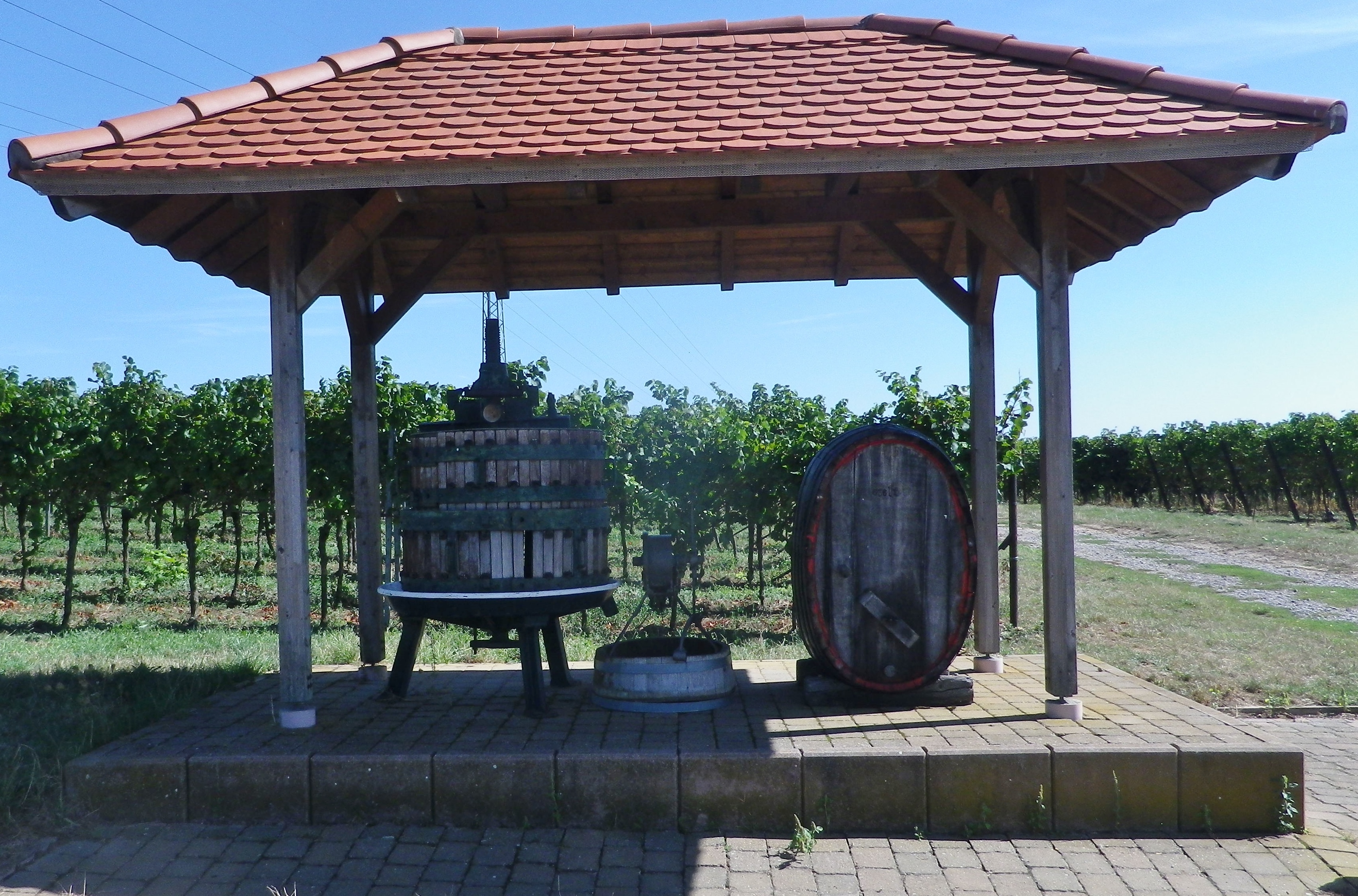
A good time on the trail was had by all that day, especially by me. This trail provided a wealth of sights and sounds, a variety of landscapes, and above all, a variety of wines to sample and enjoy!
Winzer Radrundweg: Trail in a Nutshell
Trail Name: Winzer Radrundweg
Trail Type: Medium distance circuit cycling itinerary; well-maintained and mostly paved trail surfaces, albeit with a couple of grass paths, and a few hard-packed earth surface sections, marking on the trail for the specific itinerary is sporadic.
Length:
Total – 44 kilometers/27.3 miles
Convenient to: Landau in der Pfalz, Germany
Marking: A white sign with stylized circles forming a grape cluster with two stylized riders on top
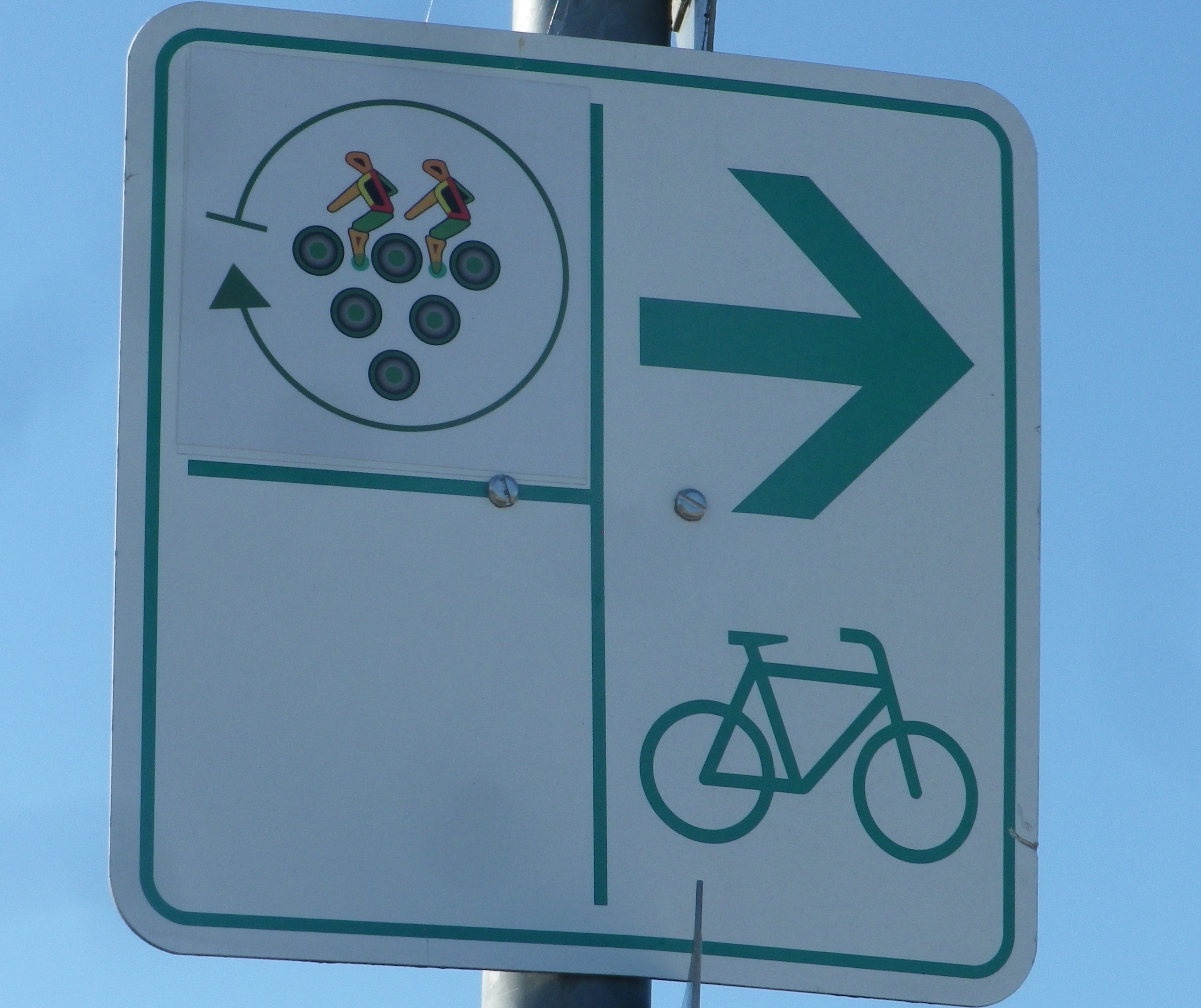
Trail Description: A delightful medium-length circuit primarily through vineyards, circling around the smaller, and lesser known (hence quieter and not as tourist-filled) wine villages of the southern part of Deutsche Weinstrasse.
Trailhead:
Official: Siebeldingen: Bismarckstr
Mine: Laundau: L509 Queichheim Hauptstr, at the Landau Zentrum exit off A65
Parking:
Insheim: Bahnhofstr;
Moerlheim (at exit Landau-Zentrum): P+R (just east of exit)
Landau: parking in and around the Freizeitbad (a water park) and the nearby Stettiner Str
Public Transportation Options:
Rail: Deutsche Bahn has frequent rail service connecting Landau with the main Rhine Valley cities via Karlsruhe.
Bus: VRN (Verkehrsverbund Rhein-Neckar) has bus lines connecting Landau and/or Bad Bergzabern (both with frequent train service) to the smaller towns and villages on this itinerary.
Suggested Stages: Not applicable
Trail Itinerary-Reference Points: (Counterclockwise)
Landau: Horststr, Horstring, Am Kugelfang; Dammheim: Am Bahnhofstr, Alte Bahnhofstr, Dorfstr, Schmiedstr; through fields, along A65; Knoeringen: Bahnhofstr, Hauptstr, Kirchstr; Walsheim: Hauptstr; through fields; Nussdorf: Kirchstr, Lindenbergstr, Am Heimlichen Eck, Kaiserberg, along Weinerlebnis Pfad; Godramstein: Unterer Steinweg, Bornergasse (P), Frankweilerstr, Kapellenweg, L511; Siebeldingen: Jahnstr, along Queich creek, outskirts; Arzheim: Hauptstr-Kalmitstr, Kapellenstr, Erzabt-Josef-Koch-Str, Ilbesheim bei Landau: Arzheimerstr, Hauptstr, Moerzheimer Str; Wollmesheim: Wollmesheimer Hauptstr, L510/Moerzheimerstr; Moerzheim: cross K6 (or turn left) Goecklinger Weg, Zum Kirchweg, Herrenstr, Unterstr, Bruehlstr, Augartenweg, fields; Impflingen: Obergasse-Bruchgasse, In der Kuhweide, fields; Insheim: Sportplatzstr, Kettelerstr, Kandeler Str-Sandweg, past train station (P), Bodelschwingstr, Offenbacherstr; Along, then over A65; Moerlheim: Moerlheimer Str; Queichheim-Landau: Queichheimer Hauptstr (P); Landau: Hauptbahnhof (P)
Representative Trail Photos:
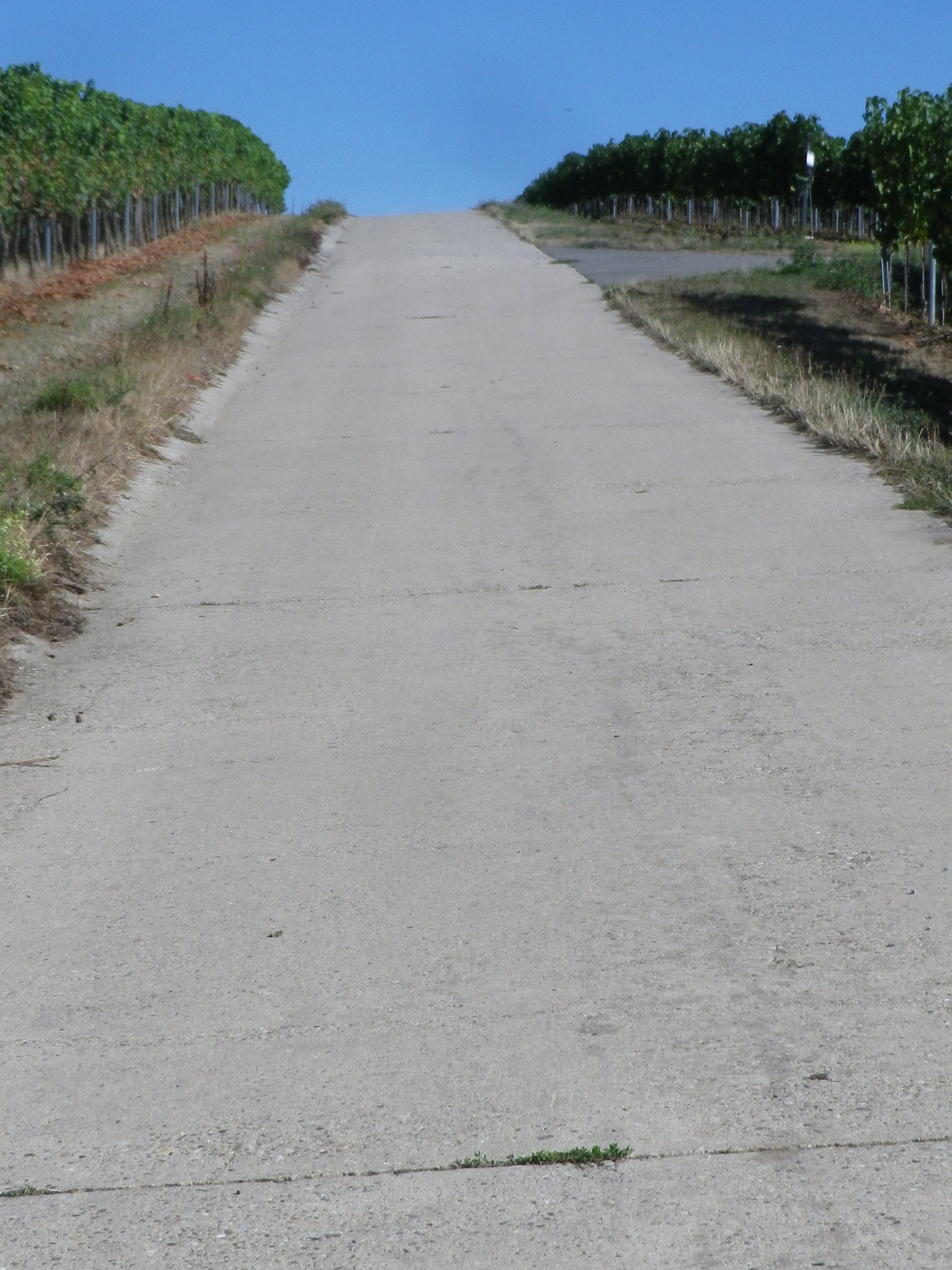
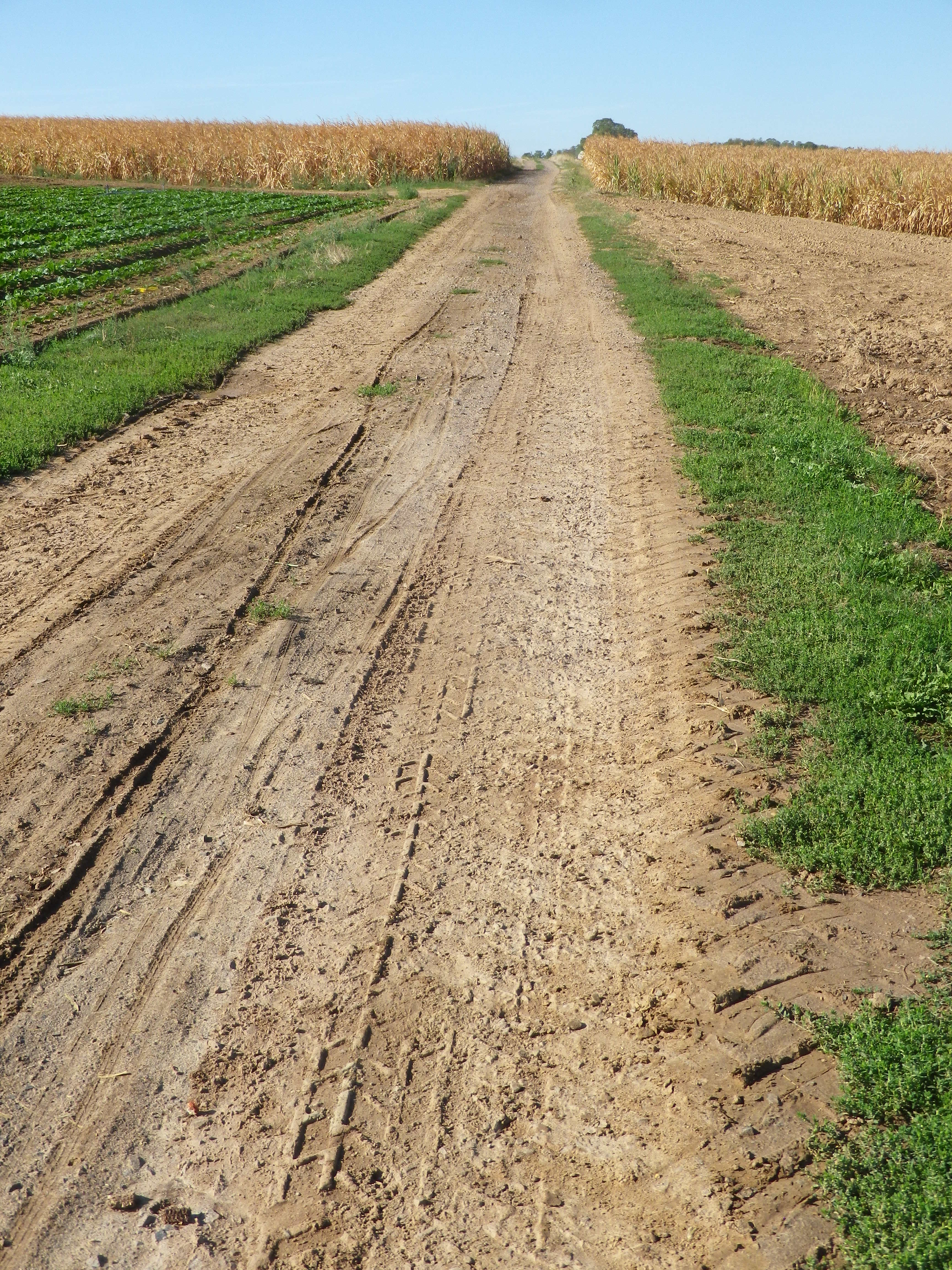
Restrooms:
Nussdorf: On the Weinerlebnispfad, in the vineyards is a small restroom set in a nice rest area.
Landau: Off the trail (but closest and pay) toilets at Am Kronwerk x Fortstr (make sure you have coins)
Attractions on or near Trail:
Seasonal local wine festivals (see below), and wine education paths Nussdorf and Siebeldingen
Tasting along the Trail:
Many wineries along the trail, most notably in Siebeldingen, Nussdorf, Ilbesheim and Godramstein; whereas Landau has a couple of wine taverns/vinoteks. Additionally, Ilbesheim, Heuchelheim-Klingen, Siebeldingen have wine festivals in September
Alternative Options:
Hiking: In Heuchelheim-Klingen, the Weinrundwanderweg, a 13.6-kilometer-long easy circuit hike through the two villages surrounded by a sea of vines. Ilbesheim, by contrast has a number of wine-themed short (2-3 kilometer) circuits. Last but not least is Nussdorf’s Weinerlebnispfad, a unique combination of visual and audio art set in the vineyards along a two-kilometer trail through the vineyards overlooking the mountains and valleys of the Pfalz.
Car: Deutsche Weinstrasse, a thematic car route itinerary of about 100 kilometers, much of it on secondary roads, past vineyards and through charming wine villages, from Bockenheim to the border town of Schweigen-Rechtenbach.)
Additional Information:
Regional: https://landauland.suedlicheweinstrasse.de/
Trail specific: https://www.outdooractive.com/de/route/radtour/pfalz/winzer-radrundweg/3201806/ or
https://vis-a-vis-pamina.eu/en/activities/
Comments:
Not a lot of shade, so perhaps best in cooler weather.
A couple of short, but steep inclines. However, overall, this is an easy to medium difficulty trail.
I included the earthen trail surface photo above to show that even the most degraded surface on this itinerary is quite suitable for most bicycles, except perhaps directly after a very heavy or prolonged rain.
A Fruitful Journey
In the Swabian hinterlands, both fruits of the vine and tree are made into alcoholic beverages. Both traditions have impressive roots, sometimes literally, dating back centuries, if not millennia. So, it was with great enthusiasm that I set off to explore this area on the Wein und Obst (Wine and Fruit) Tour.
Famed for both its orchards and vineyards, this idyllic Swabian interlude is located between Heilbronn and Stuttgart, two major cities in Swabia, both set along the Neckar River. Walheim, where the Wein und Obst Tour circuit officially begins, and neighboring Kirchheim am Neckar, where I began the circuit, are both small riverside towns. The trail connecting them followed the Neckar downstream, through shady copses, along the green embankment. It provided an easy warm-up for the rest of this trail.
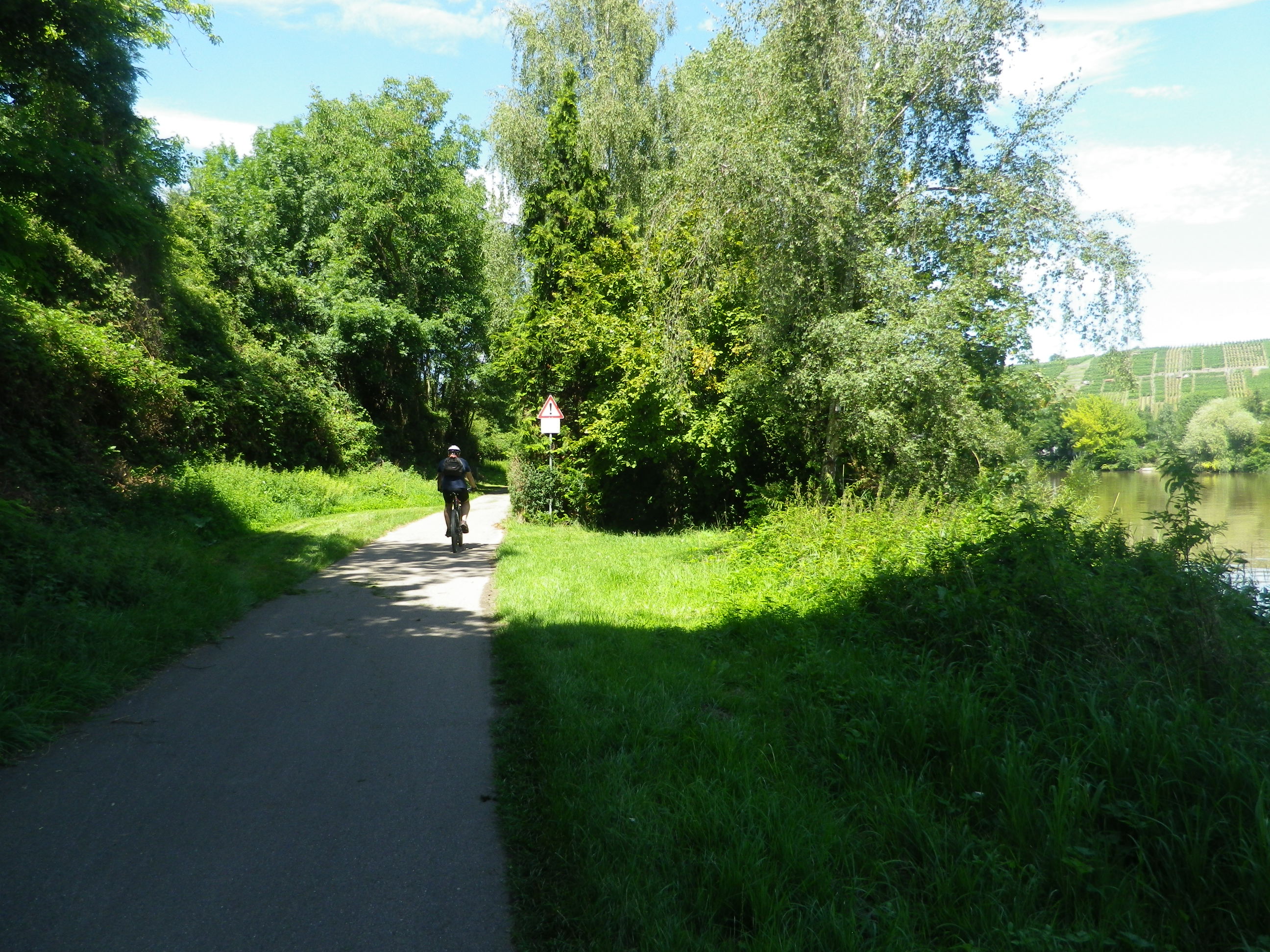
In the gently rising flatlands behind Kirchheim, the first of many orchards came into view. Some of this fruit would be made into “Schnaps” an alcoholic drink with fruit must or flavor. Apple schnapps, pear schnapps, plum schnapps, apricot schnapps, cherry schnapps, and I am sure that is not all. (If it is a fruit, somebody has undoubtedly made it into an adult beverage at some point.) So devoted are the Swabians to these local specialties, that nearby Boennigheim is home to the Swabian Schnaps museum.
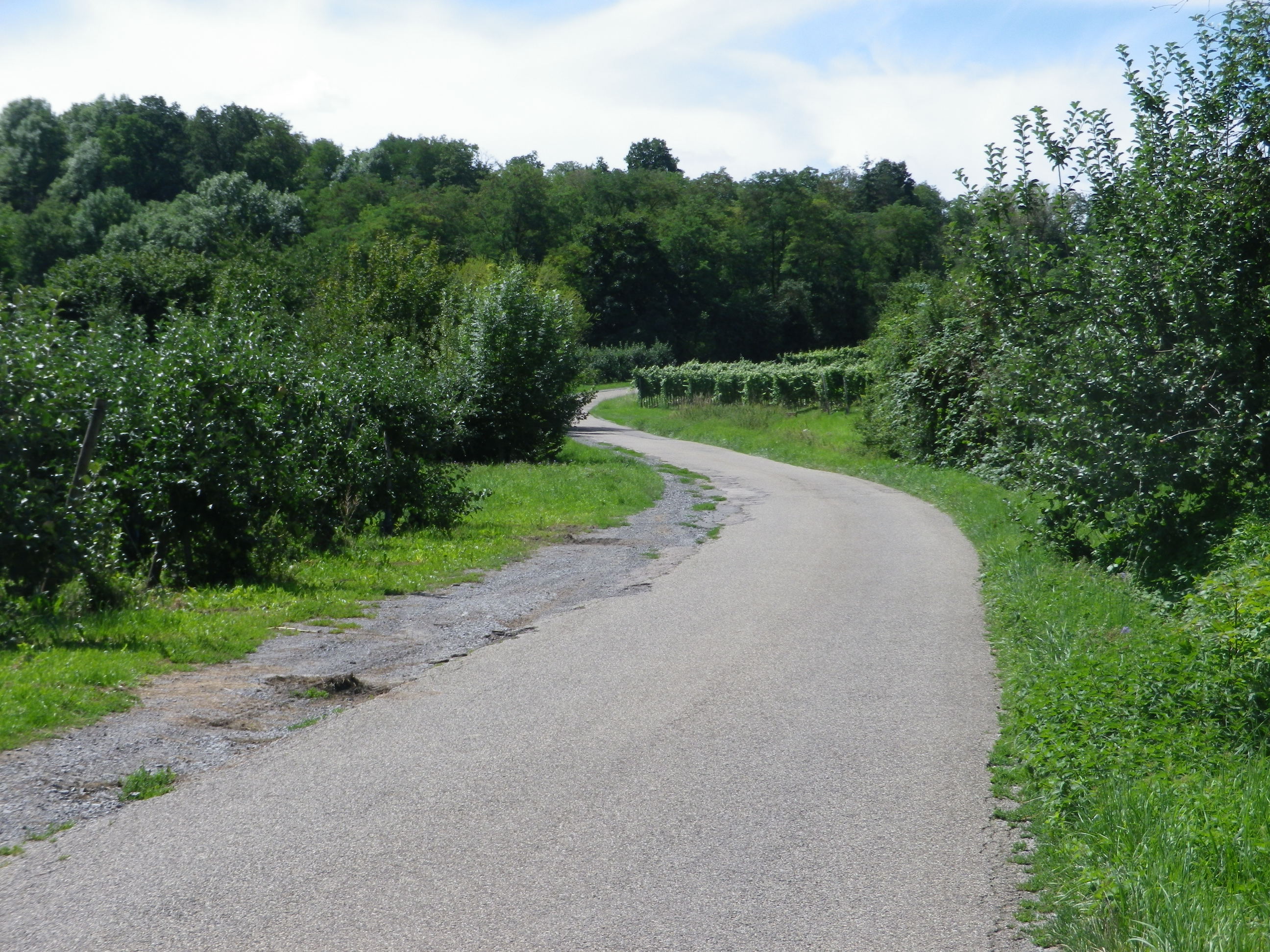
But the other passion in Swabia is wine. As the hills rose higher, I began to cycle through vineyards. The trail meandered along slopes with views of distant mountains crowned by forests, and fields of grain on lower terrain. Up hills, and down, all along accompanied by the delightful scent of fruit and pine trees.
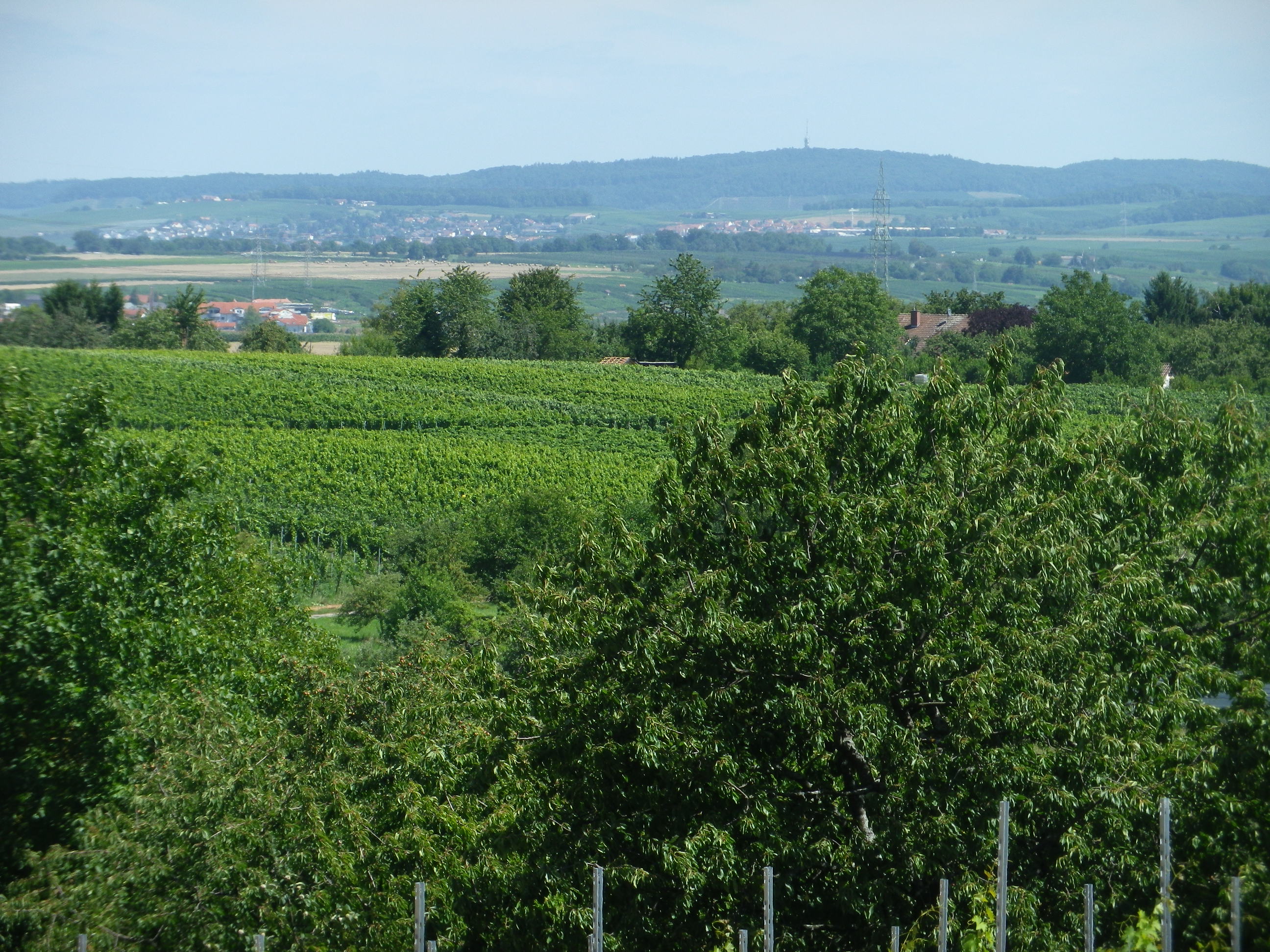
Almost not a car in sight until I reached the village of Freudental. The name literally means Joy Valley, and I can see why, surrounded as it is by orchards and vineyards, in a tranquil nook where even the king of Wuerttemberg enjoyed summers here in a “small” getaway palace. A village wine festival was in full swing as I cycled through, spreading more joy as time and wine flowed on.
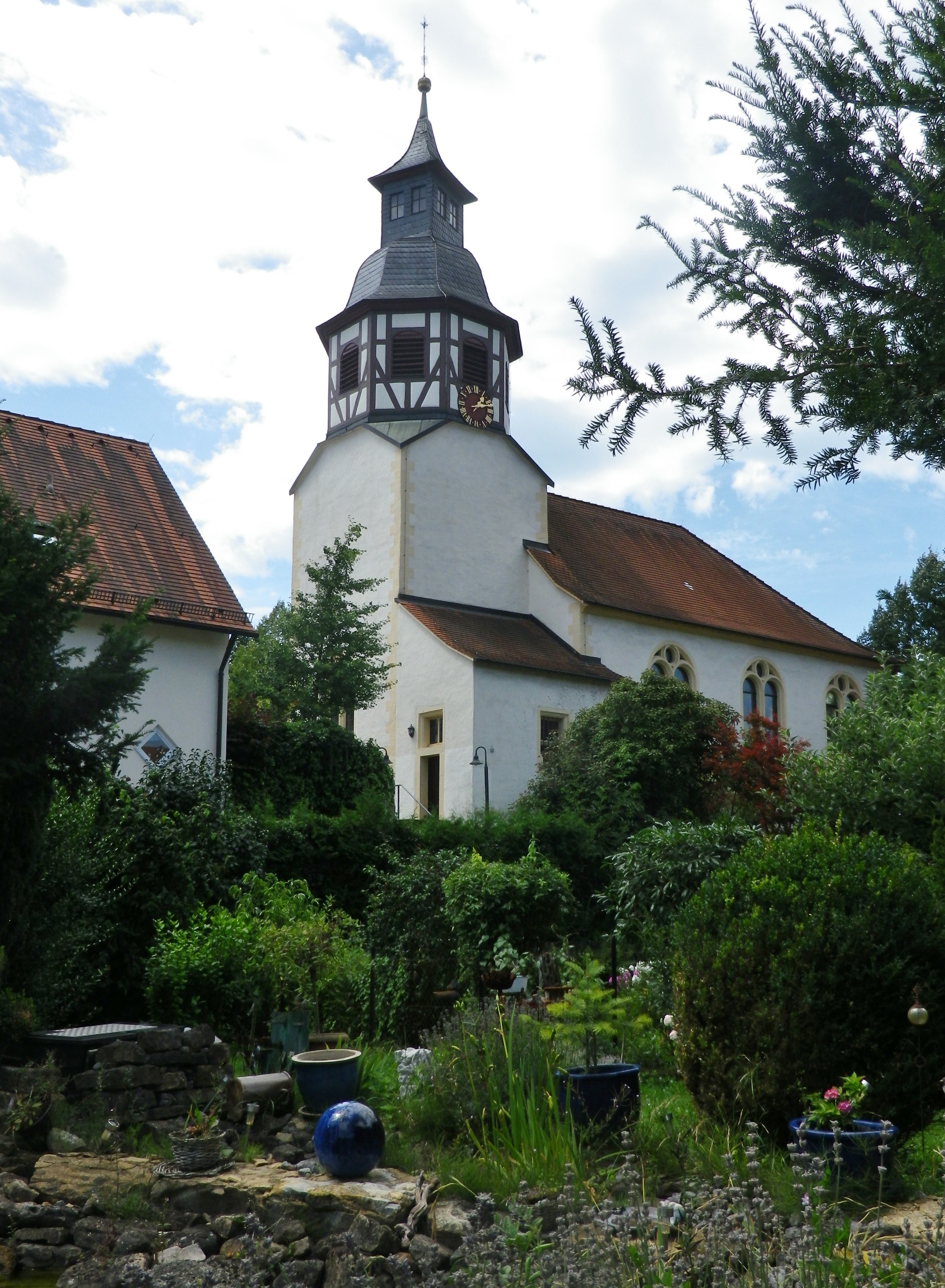
Once through Loechgau, the trail finally led downhill, along a trail as well-maintained as it was aesthetically pleasing, passing through vineyards, woods, and orchards along a quiet stream, all the way back to Walheim, where sampling the local beverages is more easily said than done! (Tip: Take your own to the Schoenste Weinsicht Besigheim, at Auf der Burg in Walheim.) While no wine or schnapps was to be had on this August Sunday afternoon, I certainly had my fill of vines and orchards on this delightful local trail.
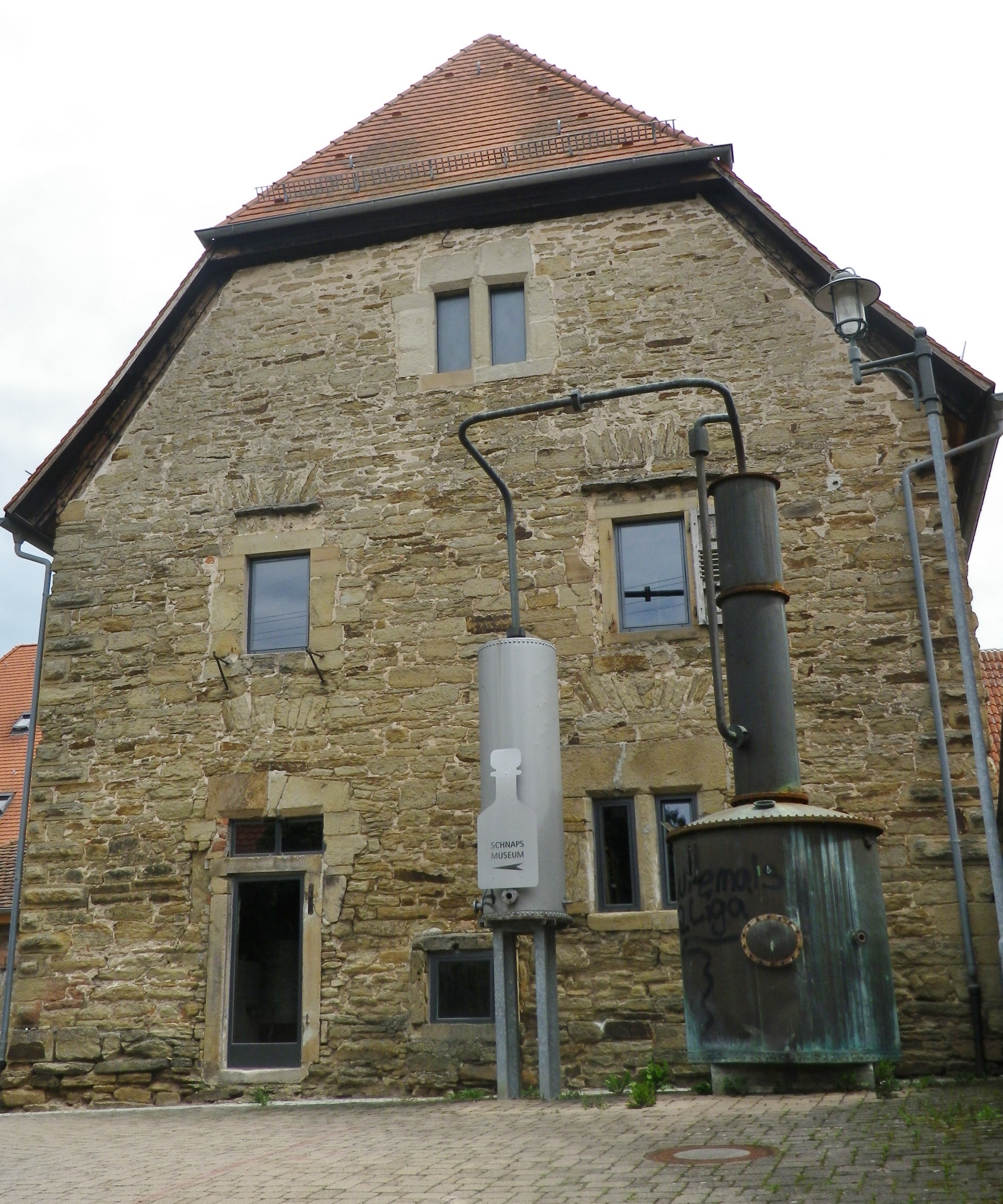
Wein und Obst Tour: Trail in a Nutshell
Trail Name: Wein und Obst Tour (Wine and Fruit Tour)
Trail Type: Medium distance cycling circuit; much of it paved, well maintained in all but a couple of very small sections, good trail signage along most of the way.
Length: Total: 25.5 kilometers/16 miles
Convenient to: Ludwigsburg, or Heilbronn, Germany
Marking: Blue lettering “Wein und Obst Tour”
Trail Description: A well laid-out cycling itinerary up and away from the Neckar River, while mostly on dedicated bike paths (or farming access lanes) through a variety of agricultural landscapes, as well as towns and villages. While not difficult, there are some hills, and a couple of long, unshaded stretches of trail, as well as the schnapps to watch out for!
Trailhead:
Official: Walheim: Intersection of Besigheimerstrasse and Hauptstrasse
Mine: Kirchheim am Neckar: Hohensteinerstr (by the sports fields)
Parking:
Kirchheim am Neckar: Ludwig-Jahn-Str x Brunnenstr (Gemeindehalle) (Check for hours) or Ludwig-Jahn-Str x Hohensteinerstr (Sports field)
Erligheim: Schulstr (sports field)
Public Transportation Options:
Bus: Some towns are served by the Stuttgart RegioBus line, with regular service to Loechgau or Kirchheim am Neckar.
Rail: DeutscheBahn regional trains (Stuttgart to Heilbronn and vice versus) serve both Kirchheim and Walheim with several convenient options every day.
Suggested Stages: Not applicable
Trail Itinerary-Reference Points:
Walheim: Haupstr-Heilbronnerstr, path along west side, then a specific crossing point to east side of tracks; follow along the river; Kirchheim am Neckar: Am Neckar, underpass, Hauptstr-Rathausstr, Bachmuehlweg-Talstr-path through fields; Hohenstein: Feldbrueckenstr-Kirchwiesenstr-Muehlstr-Mittlerestr, path to Hoffen: Neubergstr-Gutenbergstr, Sonnenhalde; Erligheim: Schulstr-Friedhofstr-Hauptstr-Talstr, Kuhaeckerstr, path (past Ferienwohnung am Weinberg, Habertsaustr (path), through woods; Freudental: Wolfsbergweg, Seestr, Kirchstr, Bietigheimerstr, path to Loechgau: Friedhofstr-Mauerstr-Grabenstr, Nonnengasse-Hauptstr, past the church, Neuestr-Kelterstr; fields and orchard paths past Baumbachhof, path along Baumbach creek; Walheim: Im der Eichhalde-Weinstr, Im Haiglen-Karlstr, rail underpass
Representative Trail Photos:
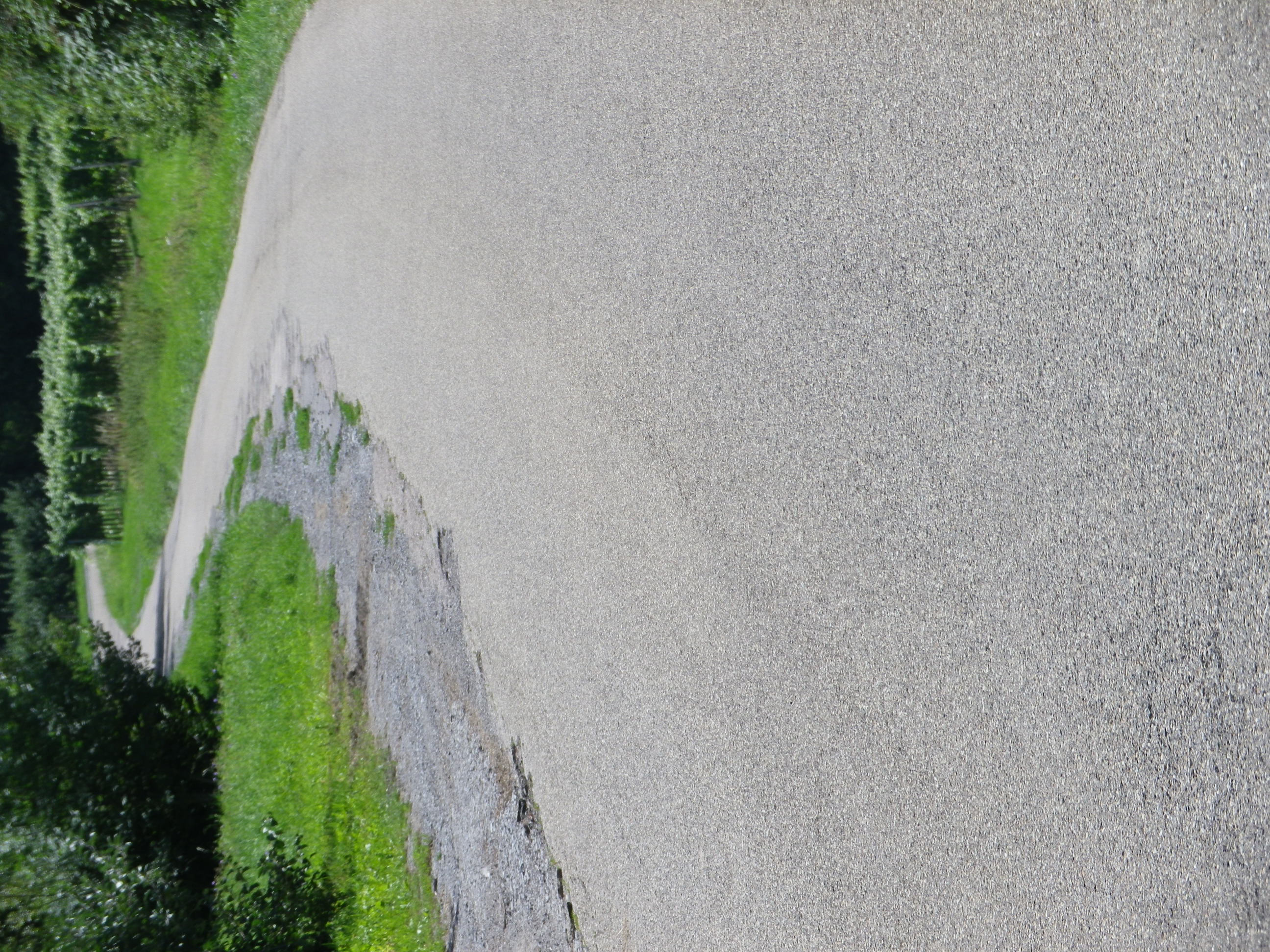
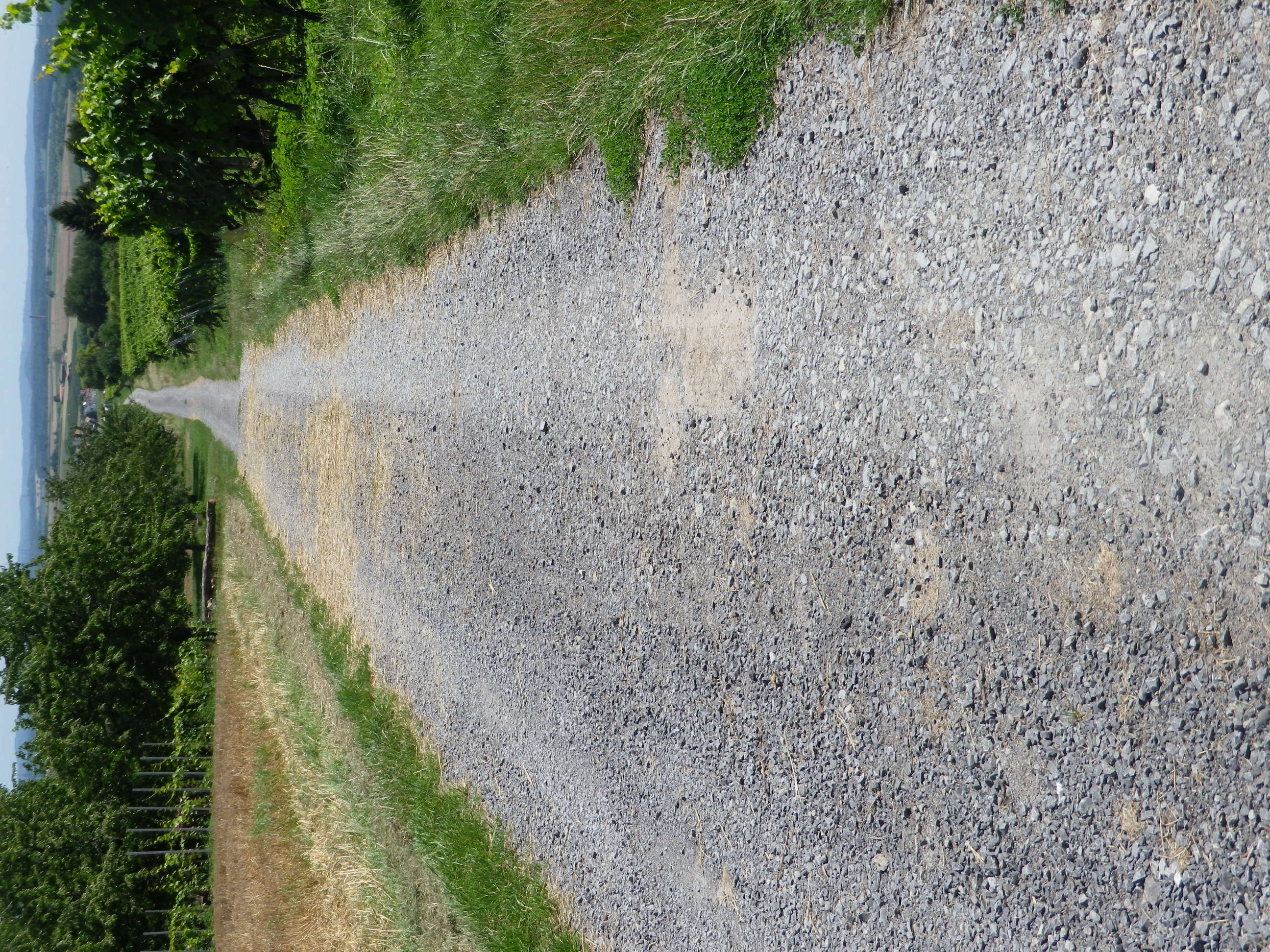
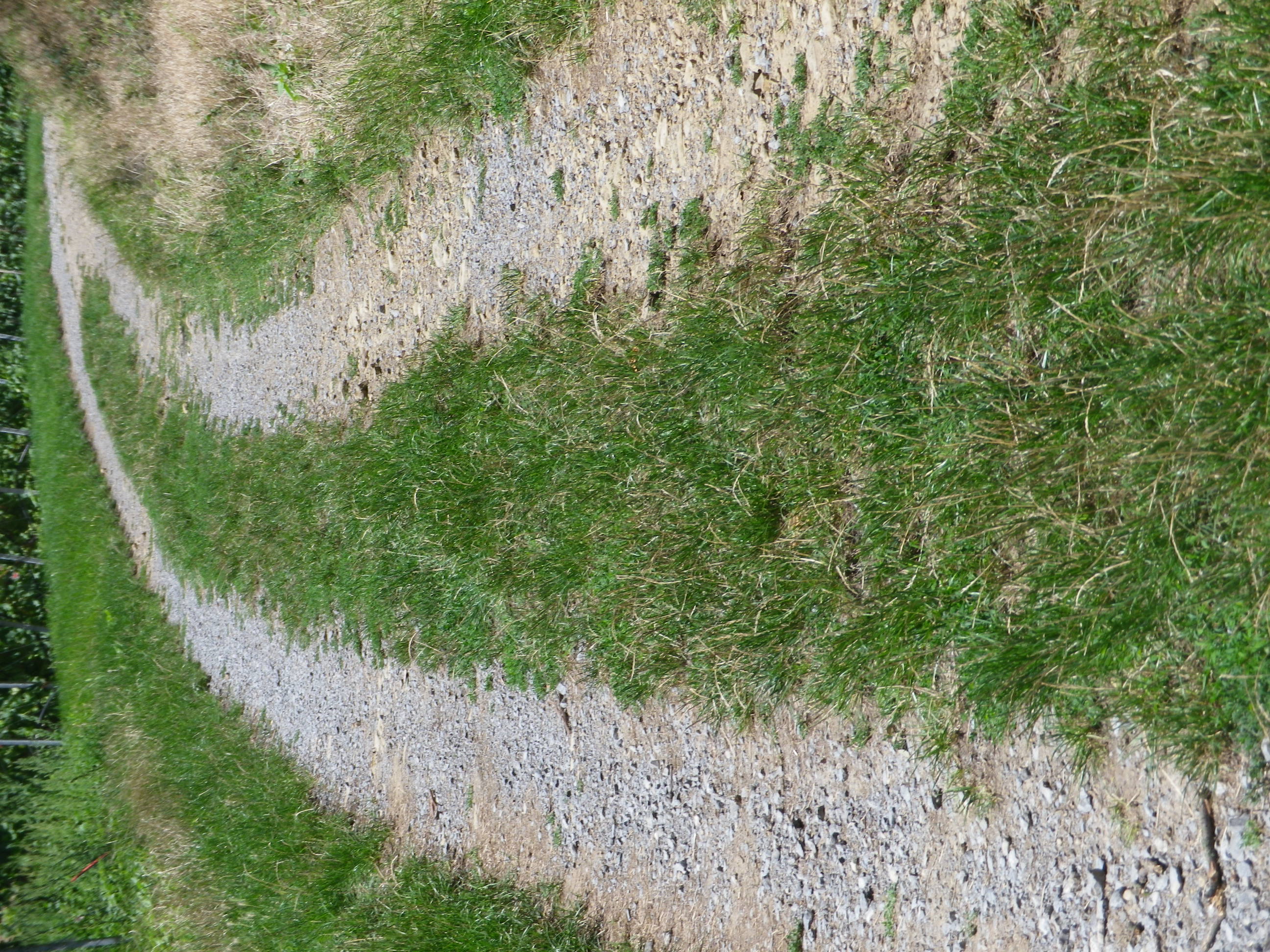
Restrooms:
None observed!
Attractions on or near Trail:
Museum in der Stiftsscheuer, in nearby Mundelsheim, provides information about local viticulture, as well as other topics.
Several viewing areas are set up throughout the region to provide great scenic panoramas over the vines, and distant countryside, the closest to the trail being the Schoenste Weinsicht Besigheim, in Walheim.
While not wine related, the Schnaps Museum in Boennigheim, displays information about the alcoholic fruit beverage of schnapps.
Tasting along the Trail:
The WG Strombg Zabergau regional winery has an outlet in Boennigheim, and is a good place to obtain bottles of some of the regionally renowned named vineyard parcels such as Kirch-, Sonnen-, Lerchen- berg. While Erligheim has several individual family wineries such as Weinbau Reichert; Weingut Baehr; Weingut Schifferer and Weingut Mayer.
Alternative Options:
Hiking: From nearby Besigheim, hikers may choose one of a couple of half-day circuits developed by the Felsengartenkellerei (a local winery), with downloadable maps at https://www.felsengartenkellerei.de/credo.html . See a Nutshell of one of them here.
Biking:
The 96.4 kilometers (64 miles) Wuerttemberger Weinradweg Variante Stromberg im HeilbronnerLand circuit tour is a much longer, and more challenging tour through the towns and nature park area of Stromberg-Heuchelberg.
The 29 kilometer Land-Wein tour is a circuit tour beginning just south of Walheim in the picturesque town of Besigheim, follwong along and crossing the Neckar River a couple of times. It shares some of the Wein und Obst Tour itinerary in the flatter areas. (See the Marking photo above.)
Car: The Wuerttembergische Weinstrasse car touring itinerary covers this territory, and more. The shorter Kraichgau-Stromberg Weinstrasse car touring itinerary covers a smaller district, heading primarily west from Erligheim. See featured photo above.
Additional Information:
Regional: https://www.3b-tourismus.de/ (The 3B stands for the three regional centers of Boennigheim, Besigheim and Bietigheim-Bissingen.)
Trail (segment) specific:
https://www.tourismus-bw.de/Media/Touren/Kraichgau-Stromberg-Wein-Obst-Tour
Comments:
A pleasant, half-day excursion, if you find yourself in the Stuttgart region and want to experience unspoilt Swabian countryside!
Days of Discovery in Aosta
Recently, I visited a quiet corner of Italy. That is almost a contradiction of terms nowadays, and rather difficult to find in the summer. Seeking a refuge from mass tourism, I came across a bike ride through vineyards in Aosta Valley. Since I had never been there, I decided to make the trip. What a trove of new discoveries of all sorts!
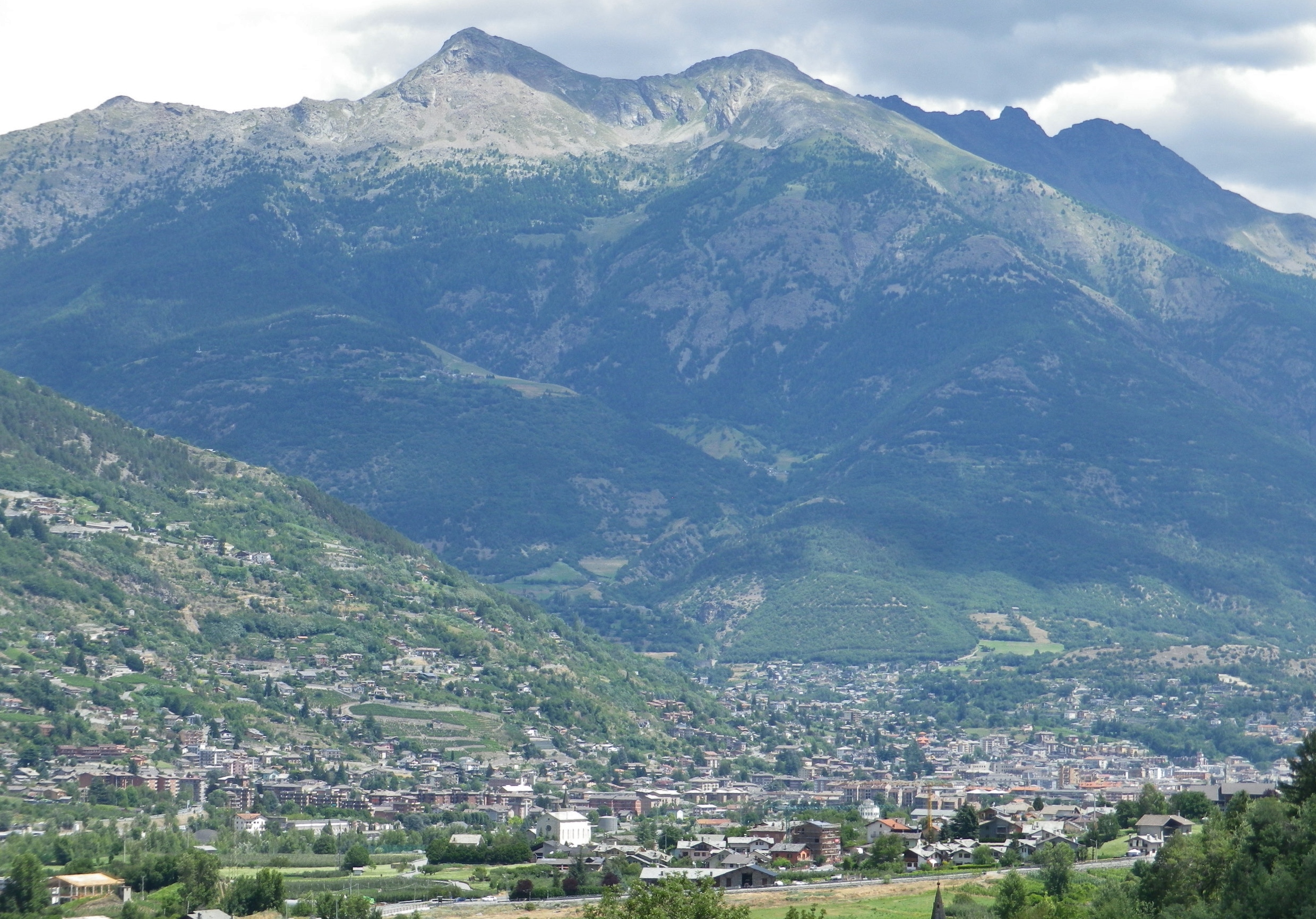
In the first place, the culture is an intriguing mix of French and Italian. Secondly, nature puts on an incredible display of the compelling and pristine: from dramatic Alpine peaks, to well-preserved meadows, to clear, roaring streams. Then, there was the food, and of course the wines.
Personally, I had never seen, or seen offered, a bottle of Aostan wine. But this bike trail was designed to rectify that. There was a clear nexus between the trail design and promotion of the local wine. The trail was designed and promoted by the local wine cooperative, the Cave des Onze Communes, in the heart of Aymavilles, a small Aostan town clinging to a mountainside, dominated by a castle and surrounded by vines.
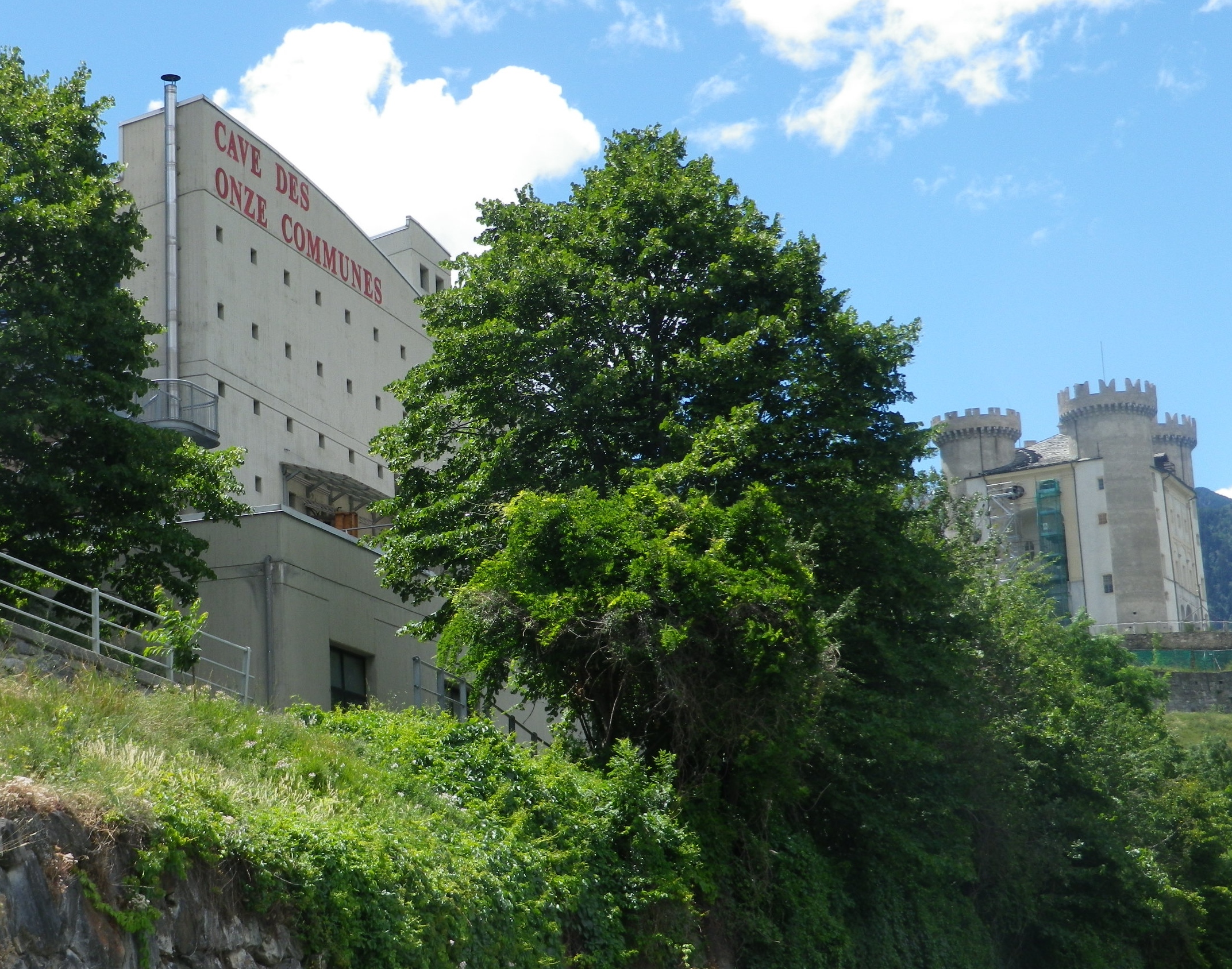
The trail, mostly on low-density/lightly-trafficked roads, either starts at the winery, or near it, or goes around it. There are actually six short segments of trail, three of which radiate from or near the winery. From there, where, and how far to go, is up to the rider.
To lengthen the ride, follow any or all of three other trails which extend from the original three. Circuits and loops may be created, and backtracking to the start is always possible, and in fact mandatory in places. However, at most there are only six miles or so of itinerary to follow, making this ideal for a quick ride.
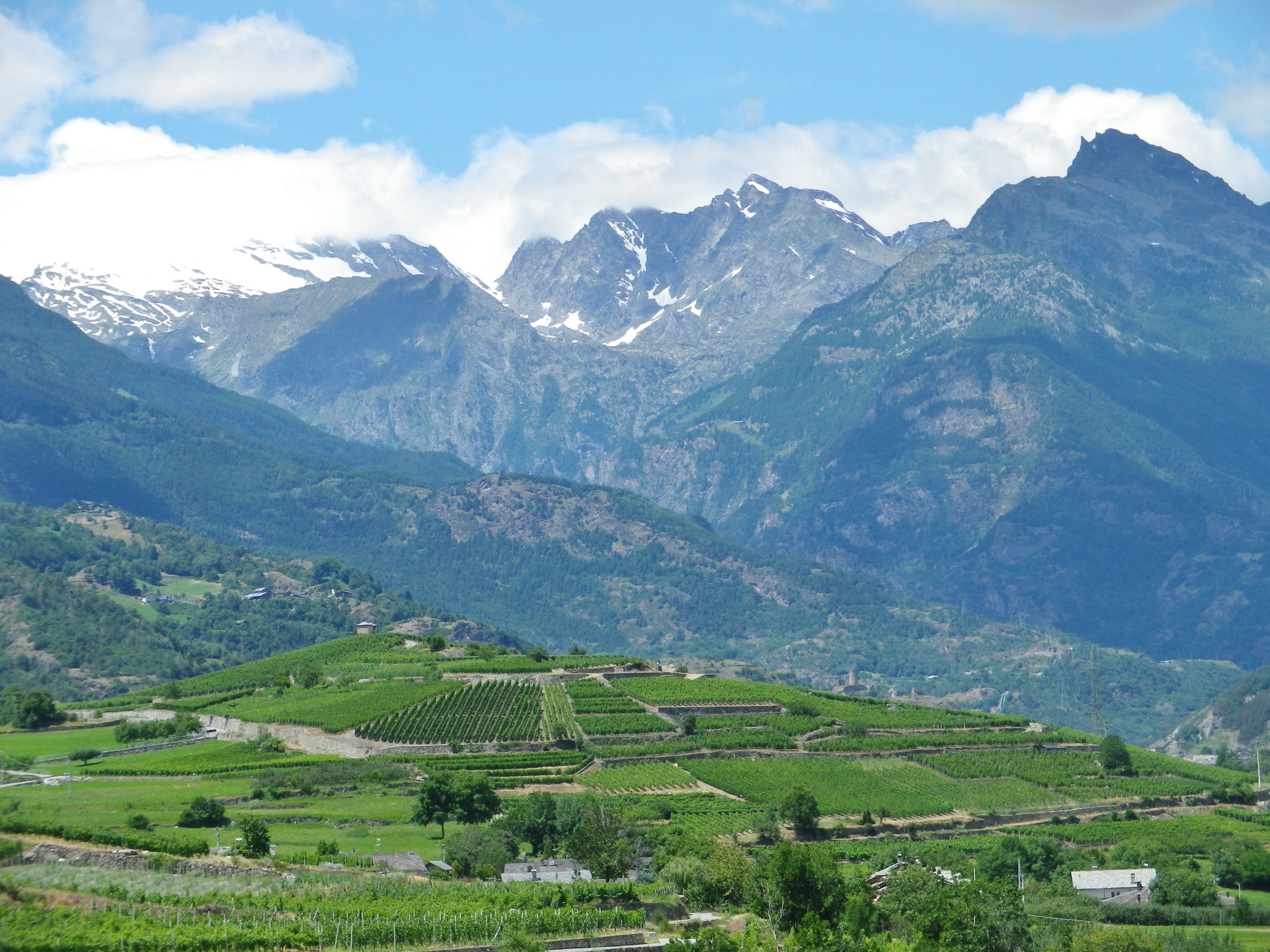
A lovely feature of this trail is the view. Mont Blanc, still topped with snow in July, is visible along part of the way, as is Aosta, the main city, in the opposite direction, further down the valley. The trail passes through vineyards, but also affords views of the vineyards on the other side of the valley. A seeming mirror image of the vineyards through which I cycled, these began low, and rose in a very irregular patchwork of vines to surprising heights on the mountains opposite. Above the vineyards were (mostly) pines, and above the tree line, rocky crags pierced the sky, in a brilliant blue on white contrast. Alternatively, those peaks would occasionally snag a cloud, and remained wreathed for a while in a soft white puff.
Castles were visible now and again, barely registering against the backdrop of such massive mountains. This area was conquered and held by many, from Romans to the House of Savoy, before joining the newly formed Italy in the mid-nineteenth century. However the old churches and houses, with steep rooves and deep overhangs, recall that the worst enemy in this part was, and still can be, the weather.
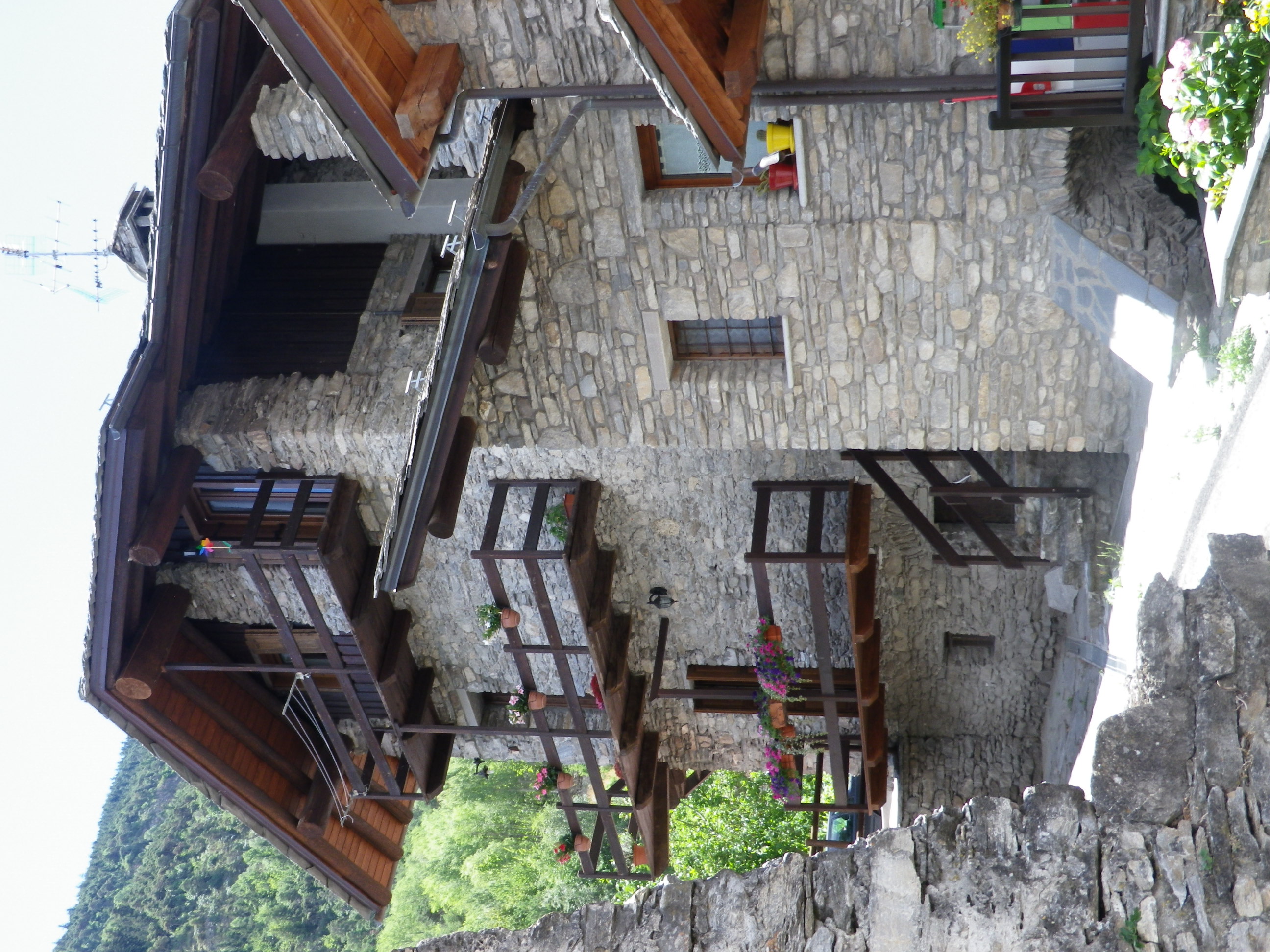
Once back at the winery though, I learned that this area boasts a fair number of local grape varieties, which do well in cold weather, and are more frost-resistant than most. What is more, the varietal wines from the cooperative are delicious, smooth, and quite reasonably priced. Unique grapes and different delicious wines: the best discovery of all!
Wine Notes: Italy’s Val d’Aosta
What I Learned:
Valle d’Aoste (Aosta Valley) is in the northwest corner of Italy, where Italy, France and Franco-phone Switzerland meet. It is an autonomous region with a heavy French influence. This influence, and of course earlier Roman settlement in the region, means that wine and wine production figure heavily in local culture. Being not only in the north, but also at a rather high elevation, wine-making is a challenge. But it is one that local winemakers have accepted, especially those vintners close to the French border, whose vineyards lie at altitudes greater than 1000 meters above sea level. (In fact, these vineyards lying below Mount Blanc (itself over 4800 meters above sea level), claim to include the highest vineyard in Europe.) While there are other contenders to that title elsewhere in Europe, there can be no doubt that Val d’Aosta winemakers work in seriously mountainous terroir.
While winemaking in such mountainous terrain is not commonplace, it is hardly unique. What is unique however may be found in the high number of native grape varieties. Both red and white varietals grow here, and thrive in the local conditions. The paragraphs below list some of the varietals, both red and white, that are native to the Aosta Valley.
The red varietal Fumin is widely cultivated throughout the central part of the Aosta Valley. Judging from the variety of Fumin Aosta DOC wines on offer, this grape produces a popular varietal wine. Cornalin is another local red varietal, which also produces an Aosta DOC varietal wine. Just over the mountains in the Swiss canton of Valais, the same grape is called Humagne Rouge. Italian vintners cultivate this varietal much less extensively than their Swiss counterparts though.
However, the most widely cultivated local varietal is the Petit Rouge in the Aosta Valley. Second place in terms of hectares cultivated goes to the Vien de Nus, a varietal named after its alleged place of origin. A minimum of 70% of Petit Rouge must be present in the Aosta DOC red wine, Torrette. Vien de Nus may be added to a Torrette cuvee, but it is never vinified as a varietal wine.
The early maturing Mayolet, almost extinct, has been rediscovered. It may be vinified as a varietal wine, a rare find, or may be added to the Torrette DOC blend.
In contrast, there is only one white varietal native to the valley. The Prie Blanc, also known as the Blanc de Morgex, is capable of maturing in some of the most elevated Valdostan vineyards. It is, as it would have to be, resistant to frosts and cold. Planted in some of the highest vineyards in Italy, it is not unusual to find that vintners make sparkling and sweet wines with this grape, although varietal wines are also produced.
What I Tasted:
2016 Pinot Gris, Valle d’Aoste Denominazione di Origine Controllata, Cave Gargantua (Gresson): A dry white wine with medium minus gold color; a citrus and peach nose, with peach, nuts and vanilla flavors; medium minus acidity, with a smooth, full-bodied finish.
2015 Fumin Barrique, Valle d’Aoste Denominazione di Origine Controllata, Cave des Onze Communes (Aymavilles): A dry red wine with dark ruby color; nose of spice, smoke and oak, with vanilla, dried cherry and red berry flavors; high tannins, with a smooth finish.
2015 Torrette Superieur, Valle d’Aoste Denominazione di Origine Controllata, Cave des Onze Communes (Aymavilles): A dry red wine blend (Petit Rouge 80%, Fumin 10-15%, Mayolet and Cornalin 5-10%) with dark garnet color; dried red berry nose, with dried red berry, blackberry, oak and vanilla flavors; medium tannins and a long, smooth finish (TDA)
2014 Petite Arvine, Valle d’Aoste Denominazione di Origine Controllata, Feudo di Maurizio (Serre): A dry white wine with medium gold color; mineral nose, with spice, wood, honey and mustard flavors; medium acidity.
Blanc Fripon, Valle d’Aoste Denominazione di Origine Controllata, Quatre Mille Metres (Chambave) with Cave Mont Blanc de Morgex et La Salle (Morgex): A dry, spumante white wine (Prie Blanc 65%, Mueller Thurgau 35%) rather still, with a light gold color; floral and fruity nose, with floral and sweet apple flavors; medium acidity.
Tour dei Vigneti: Trail in a Nutshell
Trail Name: Tour dei Vigneti
Trail Type: Short to medium distance; almost exclusively paved, well maintained, but the route itself is not always marked.
Length:
Segments – 1.5, 3.5, 5, 5.5, 8 and 10 kilometers/6 miles
Total – Variable, depending on trail segments taken
Convenient to: Aosta, Italy
Marking: Green rectangular Sign with white lettering “Tour dei Vigneti” and a number
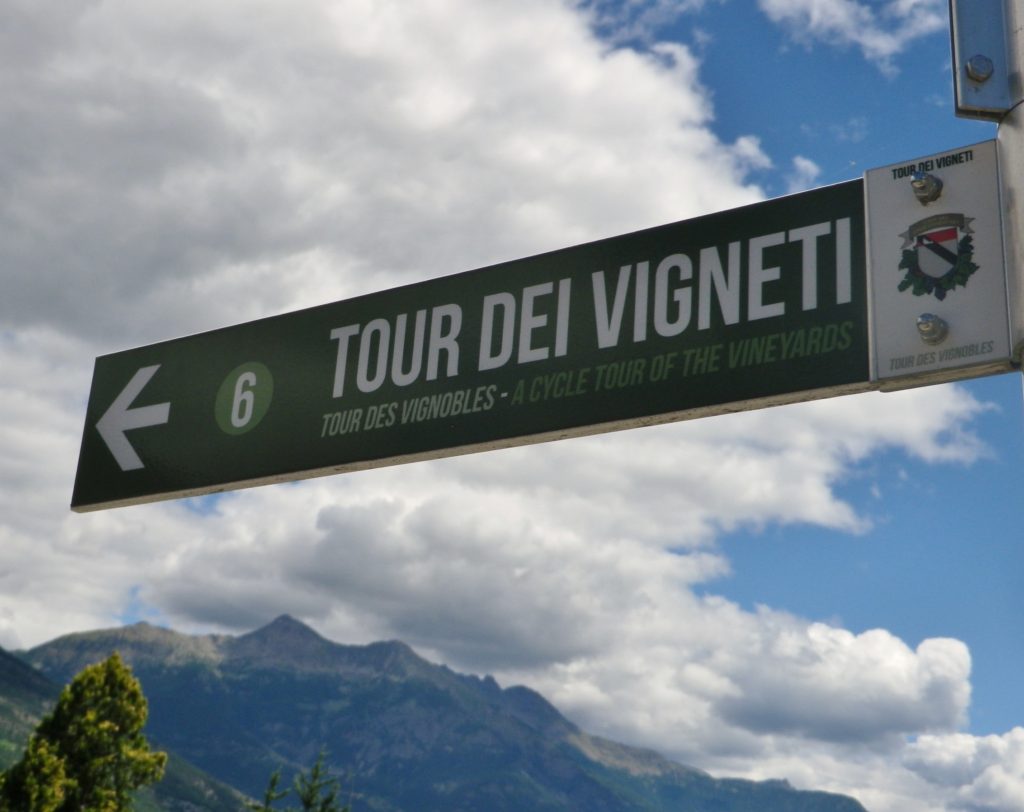
Trail Description: A series of short, one-way routes along dirt paths or little-traveled roads covering the village of Aymavilles and nearby hamlets. The numbered routes range from easy (most segments) to difficult, and may be combined according to time and/or ability, and to form circuits.
Trailhead: Cave des Onze Communes, Frazione Micheley, Aymavilles
Parking:
Aymavilles –
Small lot along SR47, just south of the Old Grizzly Café, and another lot further up the road between the roads Micheley and Urbains
In Frazione Vecellod, along street of the same name, just after the sign for the road to Aosta.
Pompoid – by the playground/sports field (basketball and soccer)
Public Transportation Options:
Bus: Societa Valdostana Autoservizi Pubblici (SVAP) Aosta-Cogne line, services Aymavilles from Aosta
Rail: No rail service to Aymavilles. (The closest rail station is in St. Pierre, about 4 kilometers distant.)
Suggested Stages:
This is a series of linked trails, branching off from one another, therefore you can choose which segments you want to do, for a total of about 10 kilometers
Trail Itinerary-Reference Points:
Aymavilles: Frazione Micheley, behind small mount and return, Frazione Pompiod; Pompiod: through village center, past soccer and basketball court, through fields; Jovencan: Frazione Adams, Frazione Pinga, Frazione Jobel, retrace partly; head to Agriturismo Mont Rosset, retrace; Pompiod: through fields and vineyards; Pompiod: retrace trail to small mount to the wine cooperative, but head south on Frazione Urbains, then Franzione Micheley around the castle; return to start.
Representative Trail Photos:
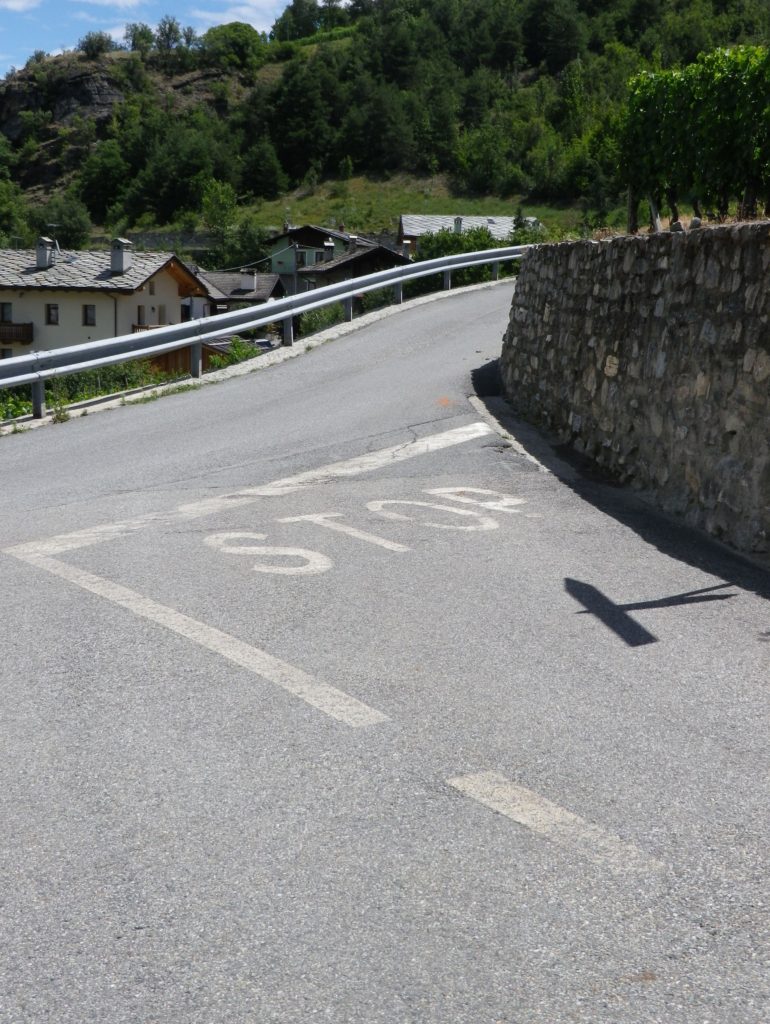
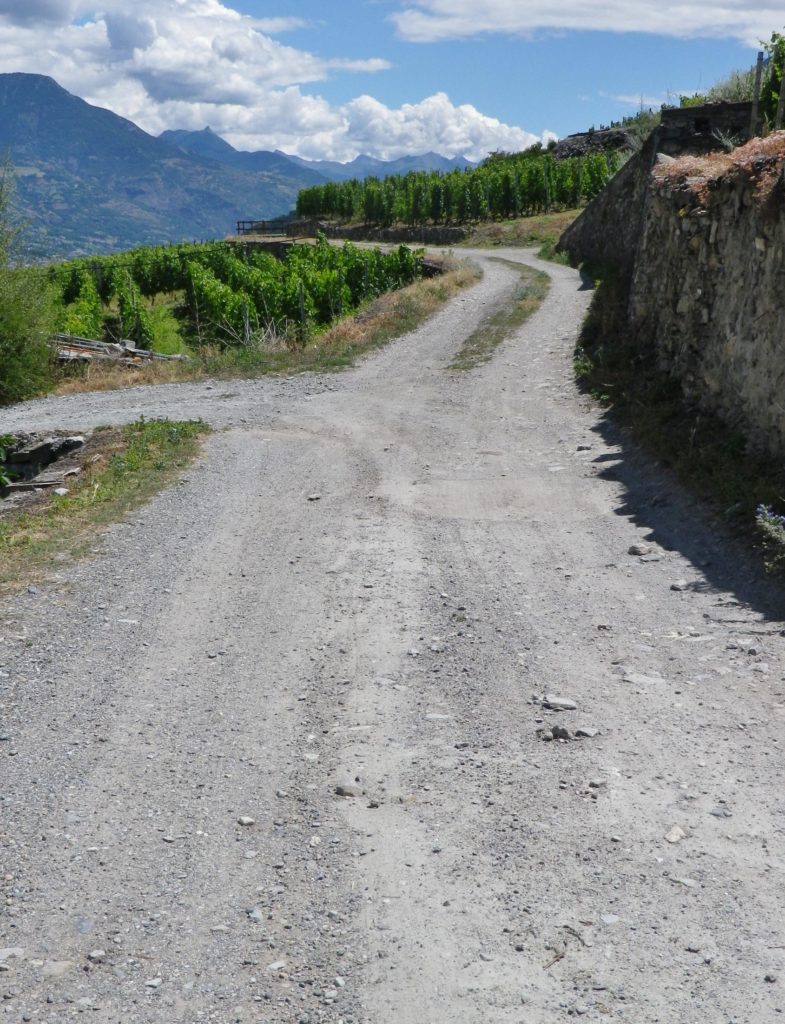
Restrooms: Aymavilles – on the lower part of SR 47 x Frazione Chef Lieu, by the church clock tower
Attractions on or near Trail:
Tasting along the Trail:
In Aymavilles, both Cave des Onze Communes and Les Cretes Viticoltori are open most days for visitors, morning and afternoon.
Alternative Options:
Hiking: Vignes et Terroirs vineyards series trails; a short circuit starts in Aymavilles.
Car: Routes de Vins Valle d’Aoste, a series of five short routes totaling about 130 kilometers, almost interlocking, covering the Aosta Valley wine producing areas.
Additional Information:
Regional: http://www.lovevda.it/en
Trail (segment) specific: http://www.caveonzecommunes.it/tour-dei-vigneti/
Comments:
The Aymavilles wine-making community designed this system of cycling itineraries for E-Bikes, which along with regular bicycles, may be rented locally. While mountain bikes are not necessary, sturdy tires are, as parts of the trail are not on asphalt! (See the photos above.)
Obviously a very short ride, but its several variations adds to its attraction. Any number of variations could prove feasible to families with tweens and teens looking for a late afternoon’s diversion; and for an early morning constitutional!
Franconian Interlude
The Fraenkische Saale, a river flowing from near the Bavaria-Thüringen border to the Main River by Gemuenden am Main, is a jewel. Its quiet, gently flowing waters, offer low-key activities for families and friends along its shores, and on its waters, from hiking and biking to canoeing and rafting. This is an area famed for rest and relaxation, and there are several well-known spa towns along the river. From Bad Koenigshofen near its headwaters to Bad Neustadt, Bad Bocklet and Bad Kissingen, all are on the Fraenkische Saale as it heads to the Main. While the Main River is extremely well-known for its vineyards and wine, the Fraenkische Saale, connecting the wine districts of the Maindreieck and the Mainviereck, doesn’t do too badly either in that regard.
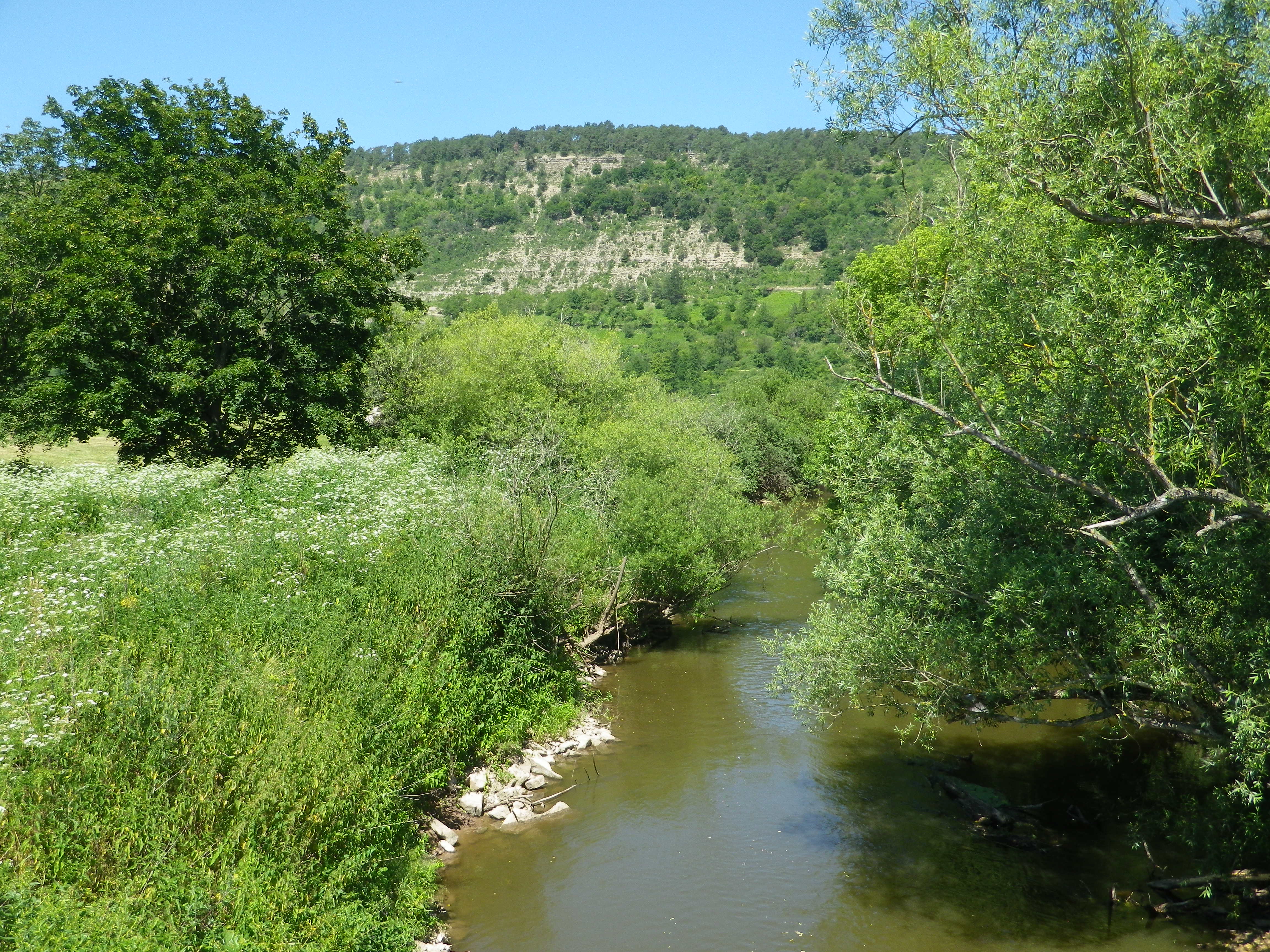
Part of the attraction for me was the opportunity to cycle along yet another river bicycle trail. Germany seems to excel in developing these trails, and the Fraenkische Saale Radweg (Bike Trail) was just another example of excellence in riverside cycling trails. The other part of the attraction for me was the chance to explore the terroir and the wines in relatively unknown wine corner of Franconia.
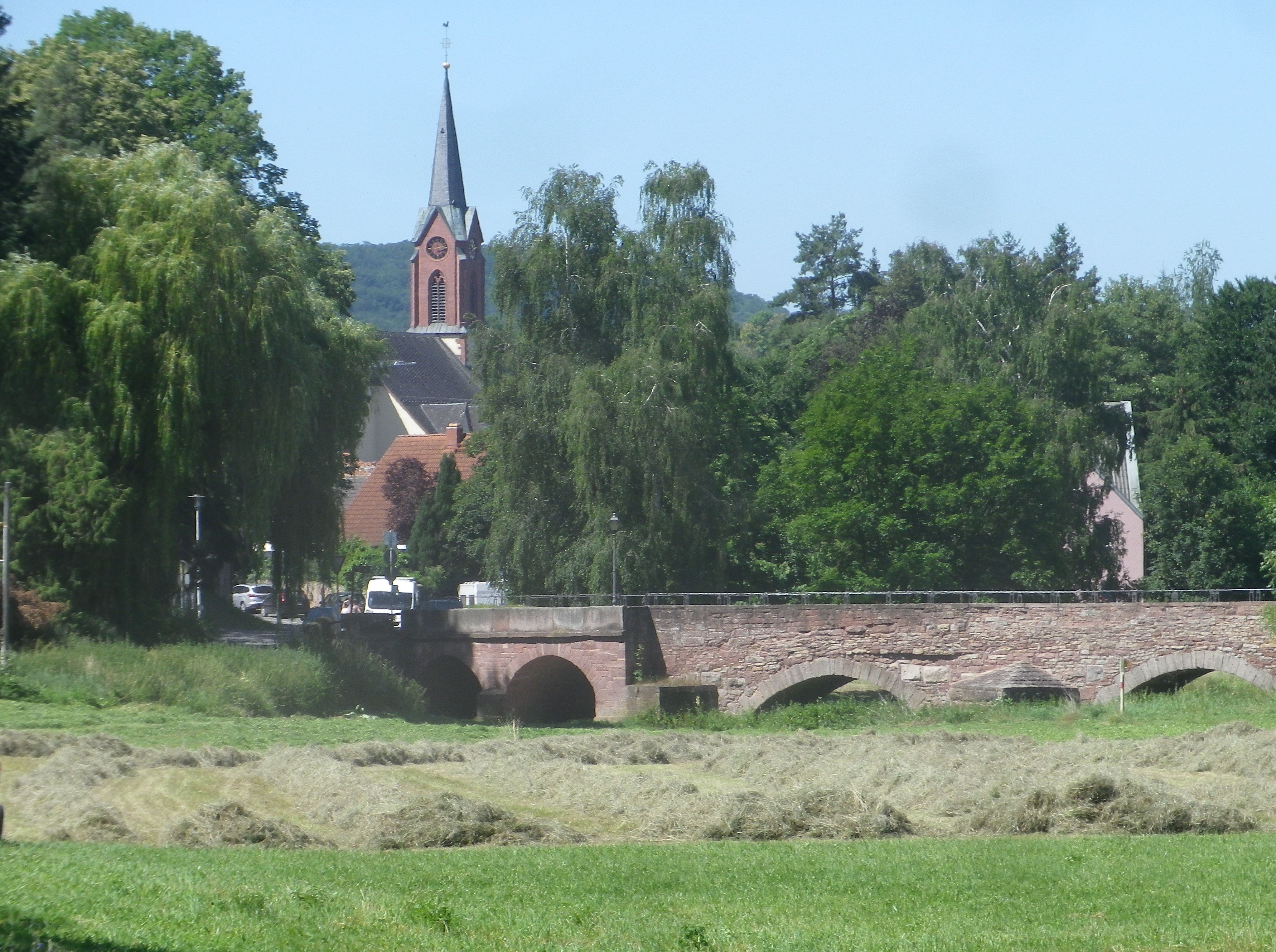
The Fraenkische Saale Radweg is about 125 kilometers, but the vineyards, Franconia’s and by extension Bavaria’s, concentrate in a short 28-kilometer-long stretch of the river and its side valleys. This made exploring them relatively easy work on a weekend. Hence, I decided to begin at Bad Kissingen, the northern and eastern-most point of my ride, one fine morning.
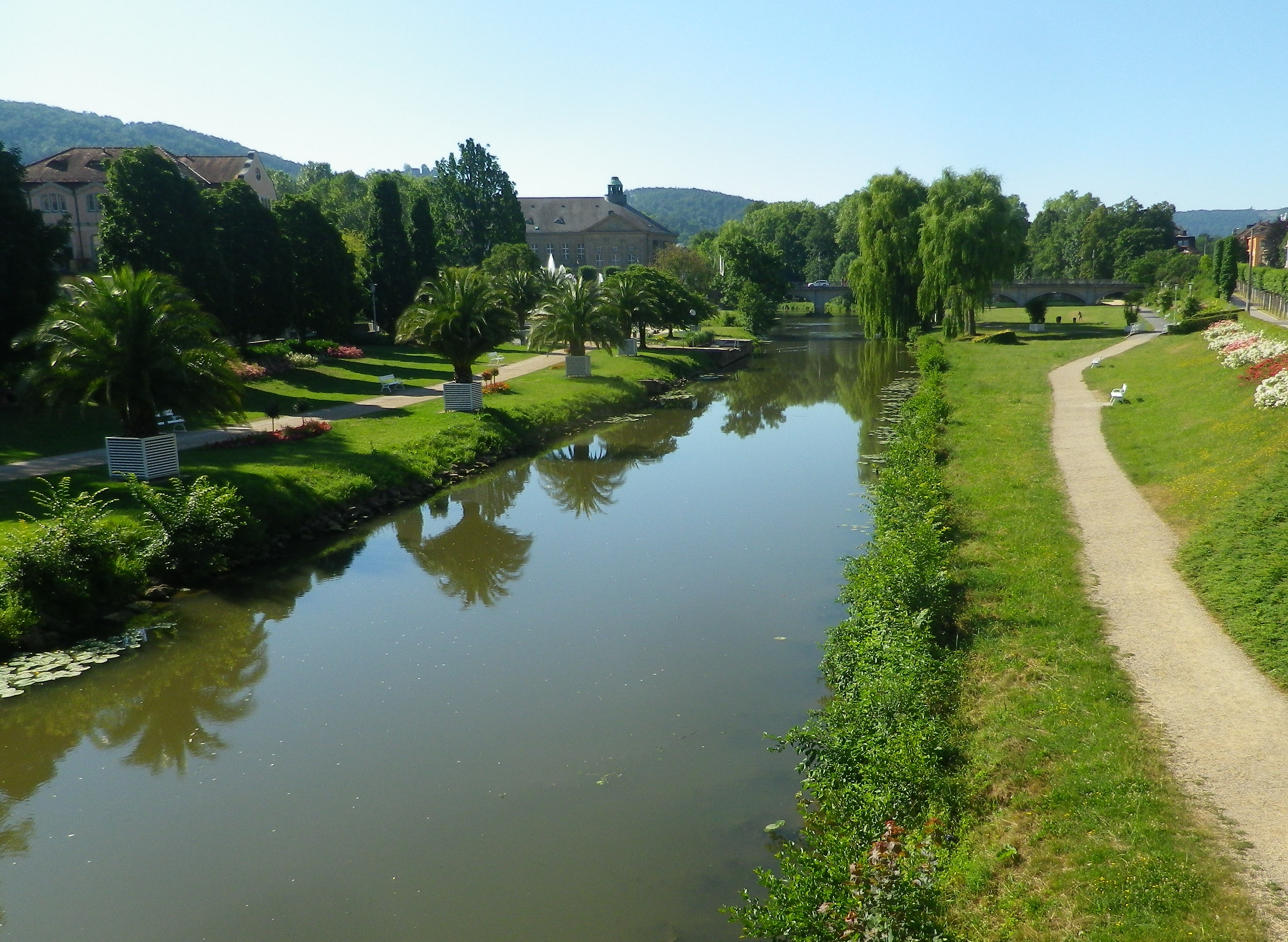
As a spa town, Bad Kissingen has a great variety of dining and lodging options to choose from. In addition, it is a lovely small town, with stately green spaces filled with curving paths along the river. The buildings are classic “German spa” and there is almost always something to attend, be it art exhibits, local festivals, or open-air concerts. I found it an excellent town to stage from, especially as the trail wove through its classic parks and gardens as it passed through town.
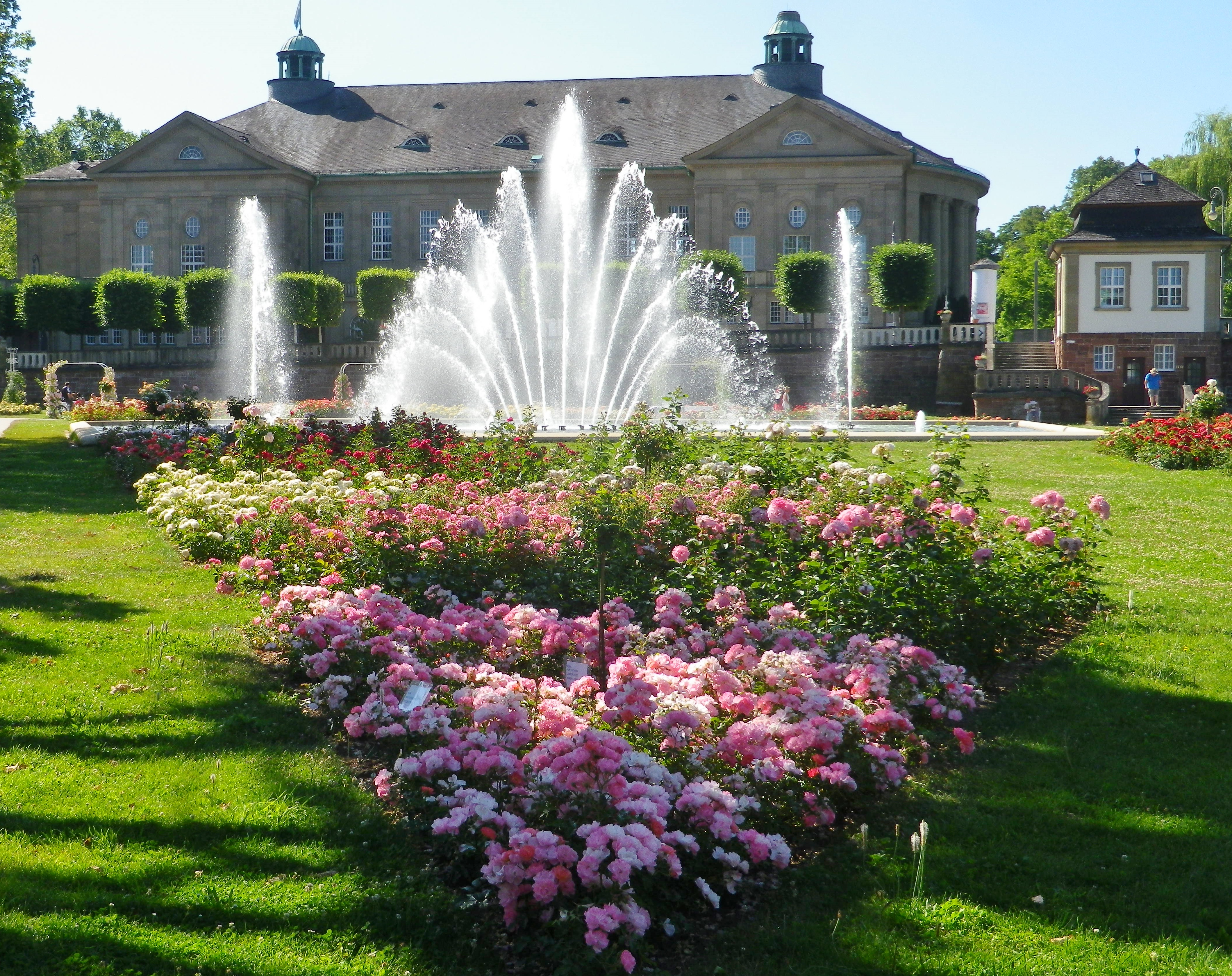
Once out of town, the trail led for a few kilometers through woods, then along fields bordering the river to Euerdorf. It proved a quiet interlude, with just nature for company. South of the Euerdorf the vineyards of Ramsthal begin.
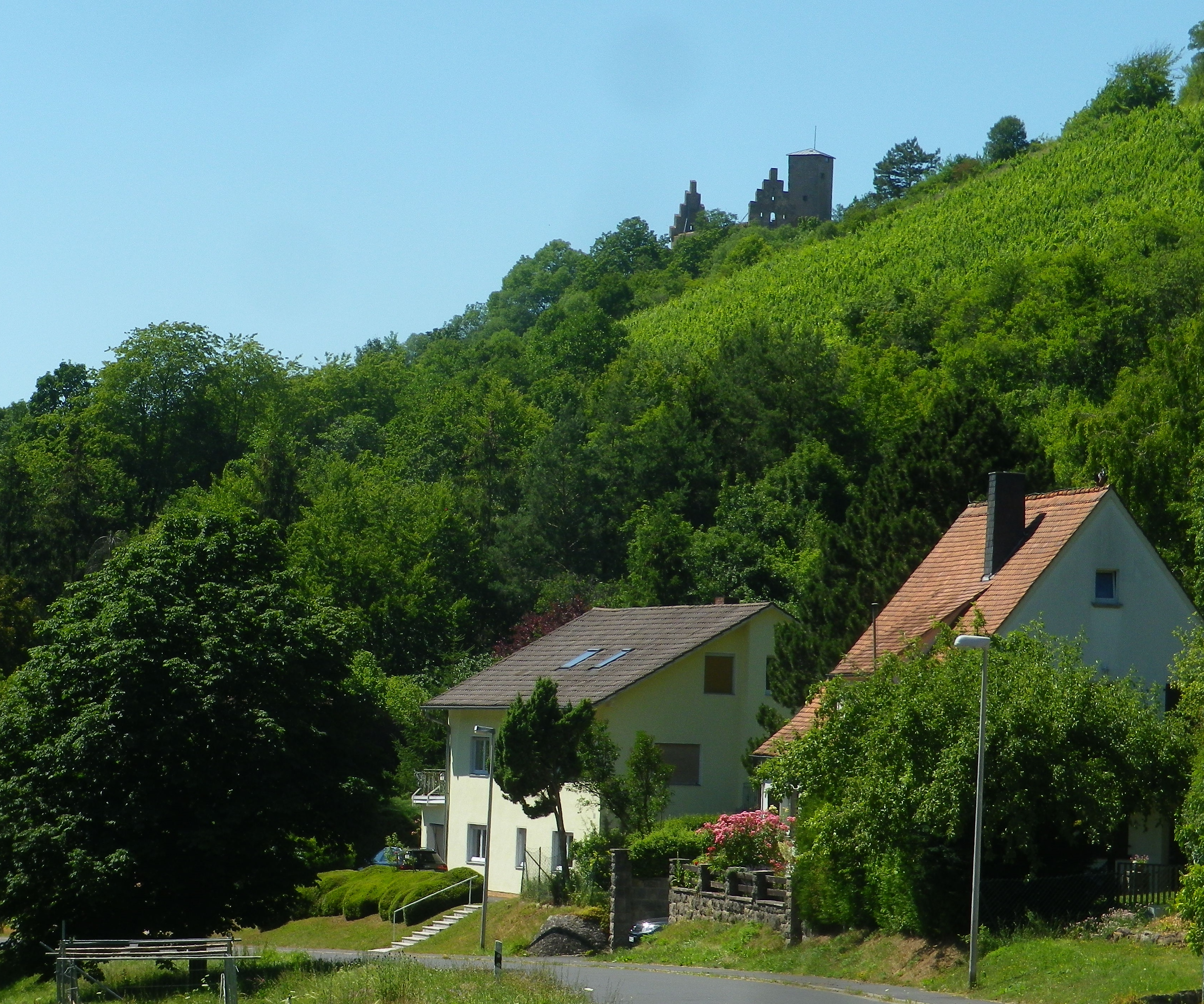
The river really does twist and turn. At Trimberg, there are more vineyards, and a castle ruin came into view. Here I crossed the river first time since leaving Bad Kissingen. But henceforth, the trail was constantly crossing the Fraenkische Saale on a series of well-maintained bridges, providing plenty of opportunities to photograph the picturesque little river. While this left me without a clear sense of where I was after so many river crossings, I was never lost, as the trail was so well marked.
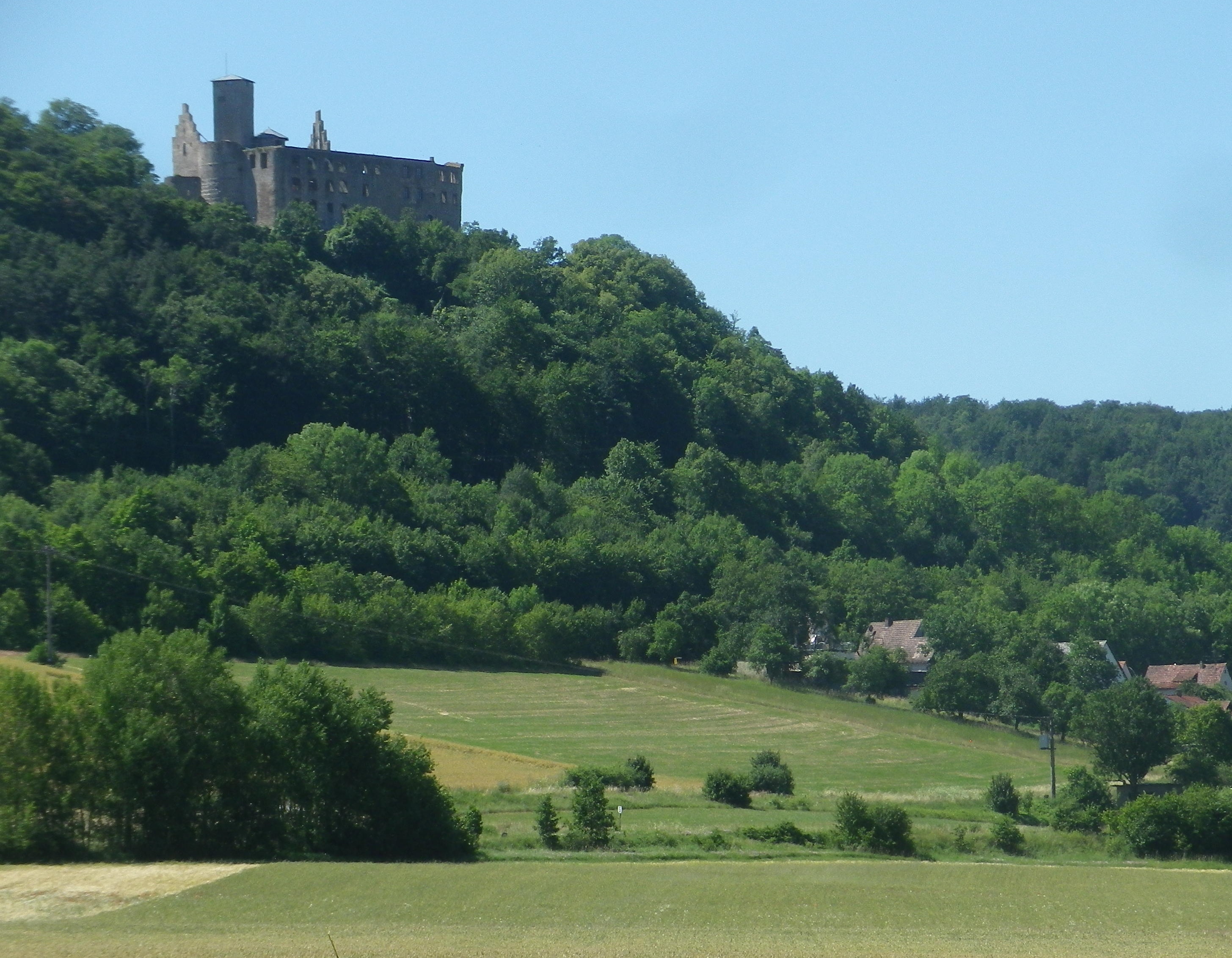
Before I knew it, I rode into Hammelburg, center for viticulture in this area. This town has a history of wine making which goes back centuries, in part due to the old abbeys. The vineyards on the hills loom over the town to the north. To the west lie the final vineyards of this wine-producing area of northern Franconia. They are in the hills above the city districts of Obereschenbach and Untereschenbach , my end destination, which was between the two sets of vineyards. While they are overseen by another picturesque castle ruin, they are not overlooked by lovers of Franconian wine!
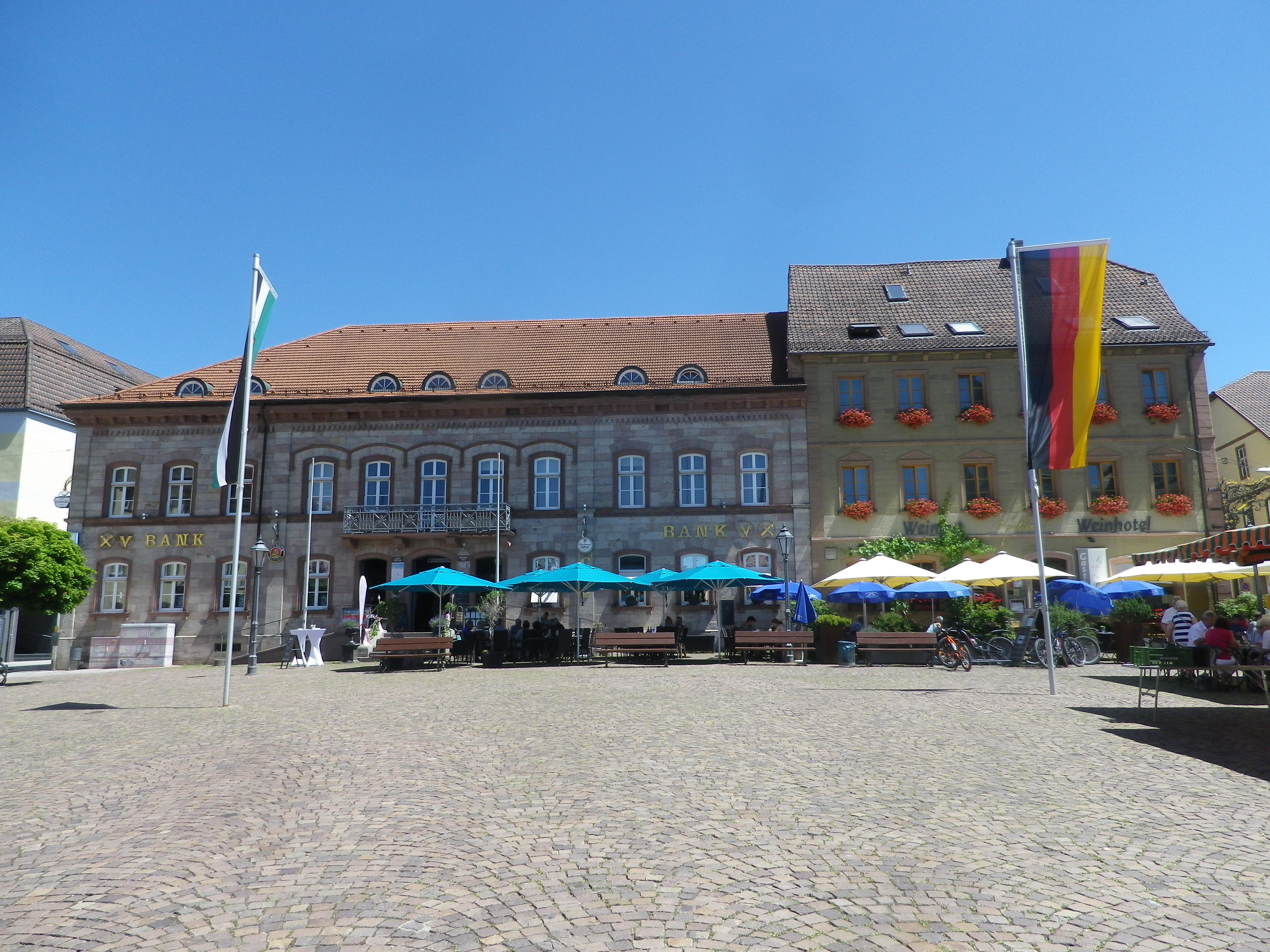
Radwanderweg Fraenkische Saale: Trail in a Nutshell
Trail Name: Radwanderweg Fraenkische Saale
Trail Type: Long distance bicycle trail (much of it dedicated bicycle trail); well-maintained and diverse surfaces from paved to crushed stone, fairly good marking along the trail.
Length:
Total – circa 127 kilometers/79 miles
My Stage: circa 28 kilometers (See Comments below)
Convenient to: Bad Kissingen, Gmuenden, Franconia, Germany
Marking: Blue background with white letters “Saale”
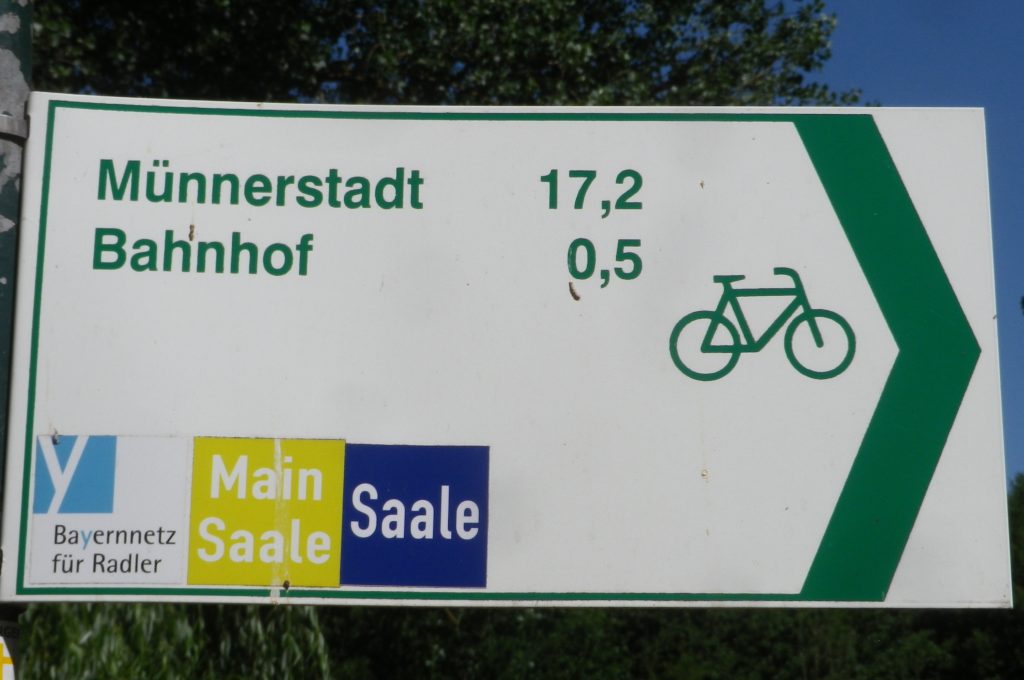
Trail Description: Fairly flat, with the inclines due to small spurs of more distant ridges, this quiet trail indeed follows mostly along the river, and through some of the riverside towns and villages, which make for great stops along the way.
Trailheads:
All Stages: -Trappstadt-Alsleben // Gmuenden am Main
My Stage: Bad Kissingen, In der Au x Bismarkstr // Diebach, Reuthweg
Parking (My stage only):
Bad Kissingen:
In der Au, dozens of perpendicular parking spaces along the lane; Costs one Euro per day/Four Euros for the week.
Maxstr, Parkplatz Tattersall is a large, improved lot, but costs more per day.
Diebach: Obertor, large unimproved area in a field (by parking sign at the eastern edge of town)
Public Transportation Options:
Rail: DeutscheBahn serves Hammelburg and Bad Kissingen with small stations in most of the towns mentioned in the trail itinerary below.
Bus: HOB Bus lines 8165, 8141
Suggested Stages: Not applicable for my stage
Trail Itinerary-Reference Points: (My stage only – heading downriver)
Bad Kissingen: Bismarkstr, Lindesmuhlpromenade (an alternate path through the park), Oskar von Miller Str, Im Lindes, past water treatment plant, parallel Iringstr; into forest, along the river, cross the Lollbach, parallels B287; Euerdorf: Ringstr, Kissingerstr, Gerbergasse, path along the river, parallel Auraerstr, Ara: Hauptstr, Trimbergerweg; Trimberg: Quellenstr, Hugo-von-Trimberg-Str-Brueckenstr; Elfershausen: Pass Elfershausen-Trimberg train station, August-Ullrich-Str, Marktstr, Langendorfer Str, cross river; Pass under A7, parallel river; Langendorf: Hauptstr, Westheimerstr, cross river; Westheim: Grenzstr, path left to cross river (two times in about 500 meters); Hammelburg: Pass Hammelburg Ost train station, An der Walkmuehle, Kissinger Str, straight at circle, continue, Am Marktplatz, Bahnhofstr, Saaletalstr, then cross tracks and follow parallel path;
Representative Trail Photos:
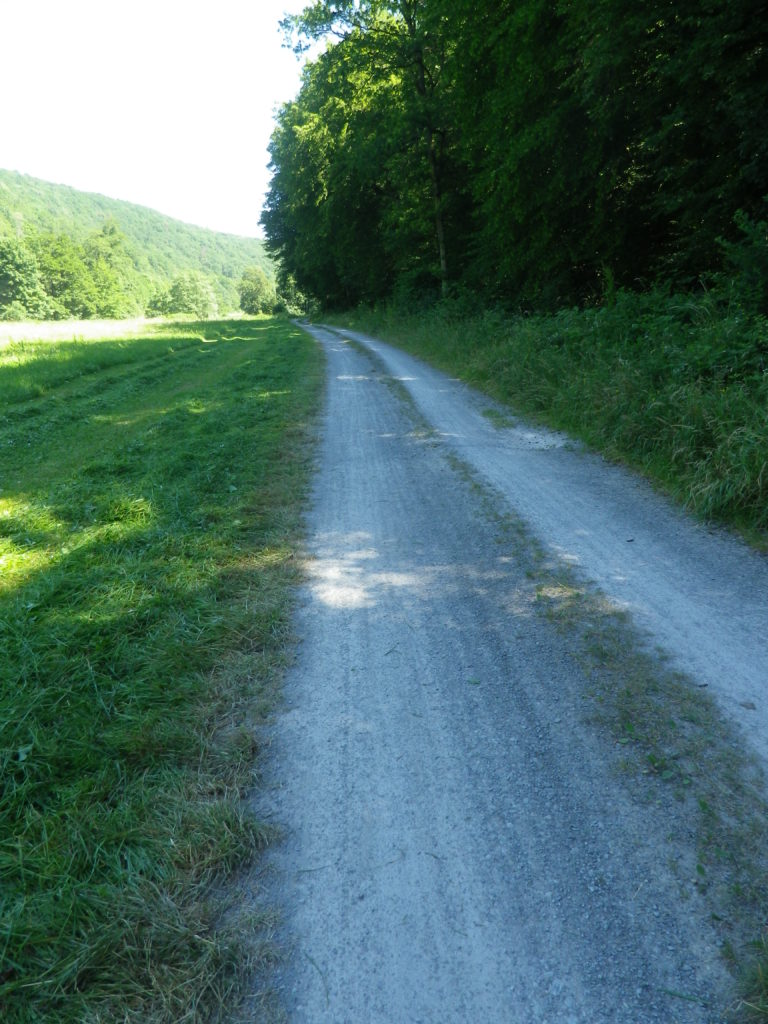
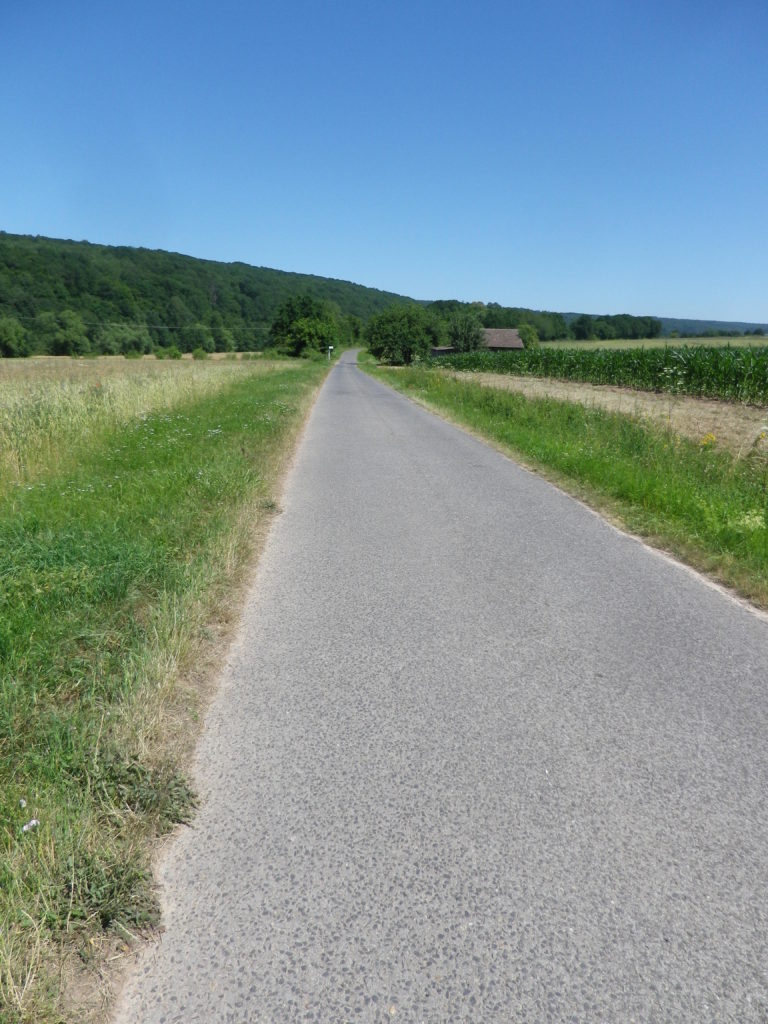
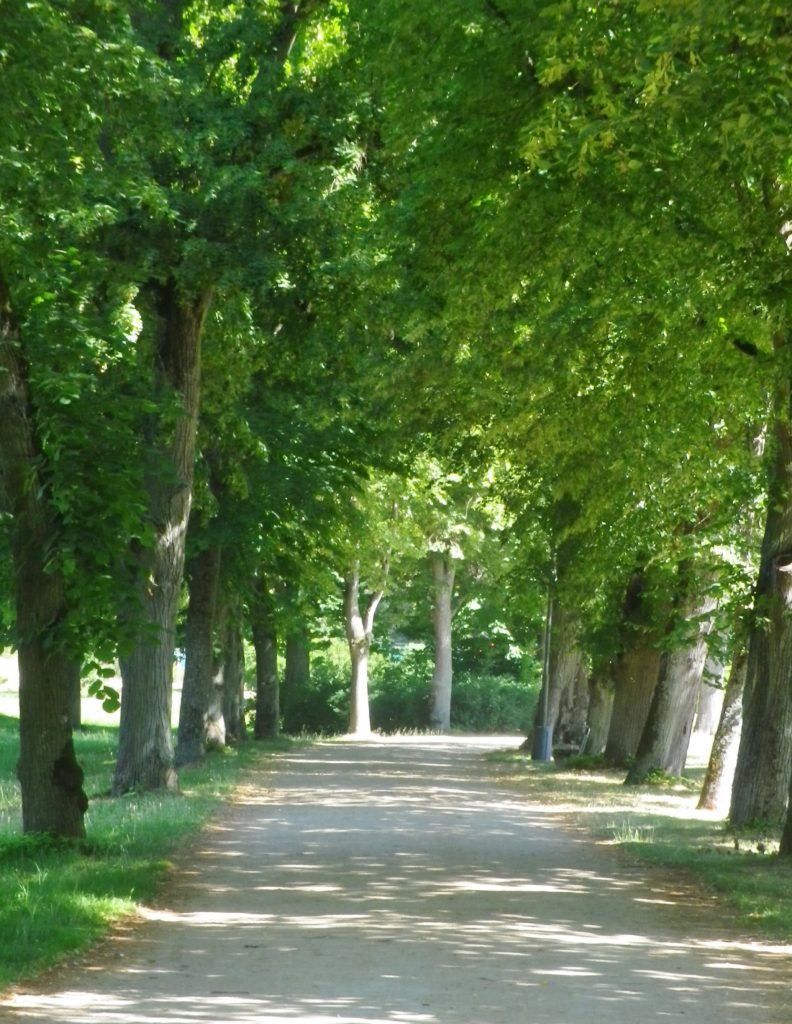
Restrooms (My stage only):
Bad Kissingen: Am Kurgarten, in the Arkadenbau (arcaded building)
Elfershausen: Schlossstr x Marktstr, at the Community Center, in an outbuilding facing the courtyard
Hammelburg: Marktplatz, on the side of the Rathaus
Attractions on or near Trail (My stage only):
Hammelburg:
Kellereischloss: Historic wine cellar, with wines on offer weekly, usually Friday evenings
Museum Herrenmuehle details the history of wine-making in this area, and with its other emphasis on bread-making, from grain to final product. A recent new exhibition combines these two items under the theme: Bread and Wine.
Tasting along the Trail (My stage only):
Hammelburg: Weingut/Hotel/Restaurant Mueller; Weingut Schloss Saaleck, Kellereischloss (see above), right on the trail; several small wineries on the outskirts of town
Ramsthal: A couple of wineries in town. (Ramsthal is about three kilometers from the river trail.)
Bad Kissingen: No wineries, but lots of wine taverns and local wine selections at the many restaurants.
Alternative Options (My stage (and wine-themed) only):
Hiking:
Rundweg Hammelburg 9: A seven-kilometer trail beginning in Hammelburg, passing in about equal parts through vineyards and forest, with beautiful views all around.
Wein und Stein trail, from Euerdorf to Bad Kissingen, a 12 kilometer-long, signposted trail of medium difficulty. See details in regional link below.
Ramsthal: The Ramsthal Weinerlebniswege: Three circuits around the town’s vine-bearing hills, ranging from the three kilometers-long Bacchus Rundweg, to the Schoppen Rundweg at 7.2 kilometers in length.
Additional Information:
Regional: https://www.frankens-saalestueck.de/weinland-franken/frankenwein-urlaub/index.html
Trail specific:
http://bay-rad.de/gpxrw/BfR_Radwanderweg_Fraenkische_Saale.gpx
Downriver only from Elfershausen to Hammelburg and Gemuenden am Main:
Comments:
The trail along the Fraenkische Saale is long, but I focused only on the vineyard part of it: from south of Bad Kissingen to just west of Hammelburg (Stadtteil Untereschenbach).
This trail connects with the Main Radweg, the Main River Bicycle Trail, leading to the Rhine by Mainz, from which point it is possible to follow the Rhine Bicycle Trail. For details on part of each trail, see the Rhine Nutshell here, and the Main Nutshell here.
